Featured Text
Alexander Calder
Alexander Calder. New York: Museum of Modern Art, 1951. Revised and enlarged edition of MoMA 1943.
Alexander Calder. New York: Museum of Modern Art, 1951. Revised and enlarged edition of MoMA 1943.


Exuberance, buoyancy, vigor are characteristics of a young art. Humor, when it is a vitalizing force not a surface distraction, adds a dimension to dignity. Dignity is the product of an artist’s whole-hearted abandon to his work. All these are features of Alexander Calder’s work, together with a sensibility to materials that induces new forms and an insatiable interest in fresh patterns of order.
Calder is an American. The most conspicuous characteristics of his art are those which have been attributed to America’s frontier heritage—“that coarseness and strength combined with acuteness and inquisitiveness; that practical, inventive turn of mind, quick to find expedients; that masterful grasp of material things,” … “that restless, nervous energy,” … “that buoyancy and exuberance which come with freedom.”[1] But Calder is a child of his own time. His vernacular is the vernacular of his age in America—an age in which the frontiers of science, engineering and mechanics have dominated the popular imagination in the same way that the national frontier dominated it a century ago.
On the side of tradition, two generations of sculptors—father and grandfather—gave him an intimate familiarity with the grammar and conventions of art. In Paris he came to know the researches of some of the most venturesome contemporary pioneers at a time when he himself was seeking a more radical departure. The result in Calder’s mature work is the marriage of an internationally educated sensibility with a native American ingenuity. Through the individuality of his work he has an established place in contemporary art both here and abroad.
The last fifty years have seen a profound reaction against the deliquescence of form which had marked Occidental sculpture since the Renaissance. Calder’s art embodies this reaction.
From the time of Michelangelo until the opening of the twentieth century, nobility of style and simplicity of technique seemed usually incompatible. The sculptor as often sought to disguise his materials as to demonstrate them. The artist developed a facile virtuosity, which during the Baroque period became a prime quality. Modeling in clay for reproduction in bronze or marble tended generally to replace direct carving. Fluidity of sculptural form reached its highest level with Bernini in the seventeenth century. But, in general, the relaxation of material disciplines led to a decay of sculptural unity and force.
With the twentieth century a desire for simplicity of form and of expression began to reappear. In sculpture the most direct route to both these ends lay through a re-establishment of the discipline of materials. The peculiarities of a raw material—the grain of the wood, the texture and hardness of a stone, the surface qualities of a metal—if respected, would exert a tonic restraint on the sculptor and his forms. African Negro sculpture was a clear illustration of the advantages of this discipline. It accepted and exploited the cylindrical shape of the tree trunk as well as the incidental suggestions of its grain and knots.
With Brancusi, virtuosity of handling gave way to the barest simplicity and directness. The orthodox materials of sculpture—metal, wood and stone—were employed once again to display their individual properties, not to simulate those of one another. The lightness and apparent insubstantiality of a polished metal surface were exploited to suggest a Bird in Flight or the shimmer of a Fish. Among the younger men who followed Brancusi we find Calder, like Henry Moore, “always ready to share credit for his work with his material.”[2]
Calder’s characteristic material is metal. He has always avoided modeling in favor of direct handling—cutting, shaping with a hammer, or assembling piece by piece. Such an approach has fostered a simplicity of form and clarity of contour in his work. It allies him with Brancusi, Arp, Moore and Giacometti in their repudiation of virtuosity.
At the same time Calder’s concern as an artist with mechanical forms and mechanical organizations, and his use of new or unconventional materials link him with the Russian constructivists of the early twenties. Open composition was their interest, as opposed to the compressed unity of Brancusi. Their aim was to expand the conception of sculptural form, so long tied to nature and to conventional materials. Instead of advocating merely a reform in the use of the orthodox materials of sculpture, the constructivists explored new materials—steel, glass, celluloid, rhodoid and the like.
The Paris cubist painters had felt that a volume could be more truthfully rendered by making its form, or a section of it, transparent. In this way features on the other side, which would normally be masked, could be seen. The constructivist sculptors carried the theory a step further, employing such transparent materials as glass and celluloid for the same purpose. Transparent surfaces led to surfaces actually nonexistent, but indicated by lines—wires, strips of wood—or merely implied by other planes. These surfaces defined “empty,” or more precisely, virtual volumes. Certain constructions organized enclosed volumes; others, by means of the implied projections of their lines and planes, were designed to organize the surrounding space; or the space within a volume was employed as a foil to a solid in a sculptural composition. Even movement was tentatively introduced by Gabo in 1920 to add a time element and to trace virtual forms in space.
This last problem is the one which Calder has explored more fully than any other artist, after coming to it quite independently of constructivism. But Calder’s most original contribution is his unique enlivening of abstract art by humor. Through humor he satisfies the observer’s appetite for feeling or emotion without recourse to direct representation. The appeal of representation had evidently been the culprit in upsetting the balance between form and subject in art. In the effort to readjust this balance the temptation had been to limit representational appeal drastically, even to expunge it. As a result the art produced by the extremists was often chilly to the point of torpor. Every living experience owes its richness to what Santayana calls “hushed reverberations.” Even without direct representation, natural materials—wood and stone—all have their funded associations for us. The “machine age” emphasis in the constructivists’ materials was a limitation. Where associations existed they were usually of an impersonal, scientific or industrial character. For their esthetic effects the constructivists could look only to formal relations of a geometrical, architectural character. Calder, however, with similar materials found a means to give a new vitality to his structures, without compromising the nonrepresentational approach. Toys pointed the way. If one can enjoy certain qualities that predominate in a toy, such as unfamiliar rhythms and provocative surprise, why should these features not be embodied in more ambitious esthetic expressions—provided, of course, they are held in proper balance with form and material?
The result in Calder’s work is the replacement of representational interests by a humor that stirs up no specific associations and no emotional recollections to distract the observer’s attention from the work of art itself. Through this conscious infusion of a playful element, Calder has maintained an independence of the doctrinaire school of abstract art as well as of orthodox surrealism. At the same time the humor in his work is a protest against false seriousness in art and the self-importance of the advance-guard painter, as well as of the academician. From this viewpoint it is a genial development of certain aspects of the dada movement.
The apparent spontaneity of Calder’s work is no accident. It is rather what John Dewey describes as “complete absorption in subject matter that is fresh, the freshness of which holds and sustains emotion … Staleness of matter and obtrusion of calculation are the two enemies of spontaneity of expression. Reflection, even long and arduous reflection, may have been concerned in the generation of the material. But an expression will nevertheless manifest spontaneity if that matter has been vitally taken up into a present experience.”[3]
Alexander Calder was born in Philadelphia July 22, 1898. His parents were both artists. His mother was a painter; his father, A. Stirling Calder, was a National Academician and one of the outstanding sculptors of the older generation. His grandfather, Alexander Milne Calder, born in Scotland, was also a sculptor, best known perhaps for his equestrian statue of General Meade in Fairmount Park, Philadelphia and for his figure of William Penn on the dome of the Philadelphia City Hall.
Calder’s early years were spent in an atmosphere of art. His parents’ friends were artists. He grew up in a studio. He became familiar with the procedures of painting and sculpture while posing as a model now for his mother, now for his father. Still, art as a calling had very little appeal for him at the outset. The precedent of two generations made it seem unenterprising. Tools were his main early interest, not brushes and clay.
Tools and an evident mechanical ingenuity suggested engineering. From 1915 to 1919 he studied at Stevens Institute of Technology. The four following years were given over to engineering. Then, in 1921, some drafting work in an engineer’s office awakened a dormant interest. Shortly afterward he began to draw regularly at a public night school on East 42nd Street, New York. The work was elementary drawing in charcoal, but he was enthusiastic and seldom missed a night.
The following summer he worked his way on a freighter through the Panama Canal to California. In the autumn he took a job in a logging camp in the state of Washington. Once again the old interest stirred and he wrote his mother for painting materials. He came east in the fall of 1923 and enrolled in the School of the Arts Students’ League.

During his first year at the League School he studied two or three months with Luks, one month with Du Bois, a month or so with Robinson, and every evening with John Sloan. At the same time he tried his hand at various types of free-lance work. In 1924 a job doing regular half-page spreads for the National Police Gazette provided a congenial opening. The drawings were not distinguished. Throughout the series, however, we already see hints of that humor and observation which mark his mature work. This is especially true of the captions. And one of his assignments opened up an interest which was to play a major role in his future development.
In the spring of 1925 Calder was given a two-week pass to cover the Circus. One performance was enough to fill his half-page. But every evening saw him back sketching in the menagerie tent. He made the acquaintance of Dexter Fellows, Barnum and Bailey’s famous publicity manager, and his pass was renewed for the following year.
The first product of this experience was a small book, Animal Sketching, published the following spring. But this interest in the Circus was to have much more important consequences. Out of it was to grow his miniature circus which brought him into touch with some of the leaders in Paris at a time when their stimulation was most valuable to him. Still more important, this miniature circus was to serve as a laboratory in which some of the most original features of his later work were to be developed.
The year 1926 saw the exhibition of his first oils in The Artists’ Gallery on East 61st Street, New York. This exhibition brought him his first critical notice, a line by Murdock Pemberton in The New Yorker: “A. Calder is also a good bet.” Yet he was by no means certain that he had found his medium. He wanted to do something of his own. But he was a sculptor’s son and a sculptor’s grandson. And a piece of oak fence-rail picked up that spring in Connecticut reluctantly took the shape of his first wood carving—the Flattest Cat.
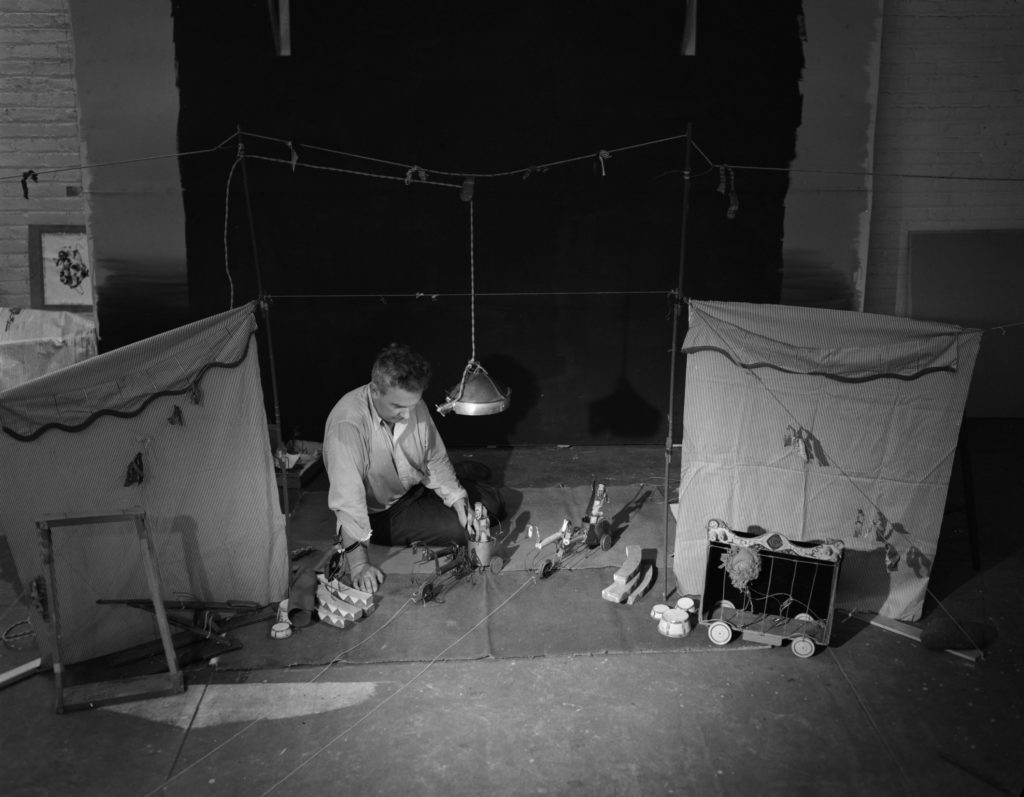
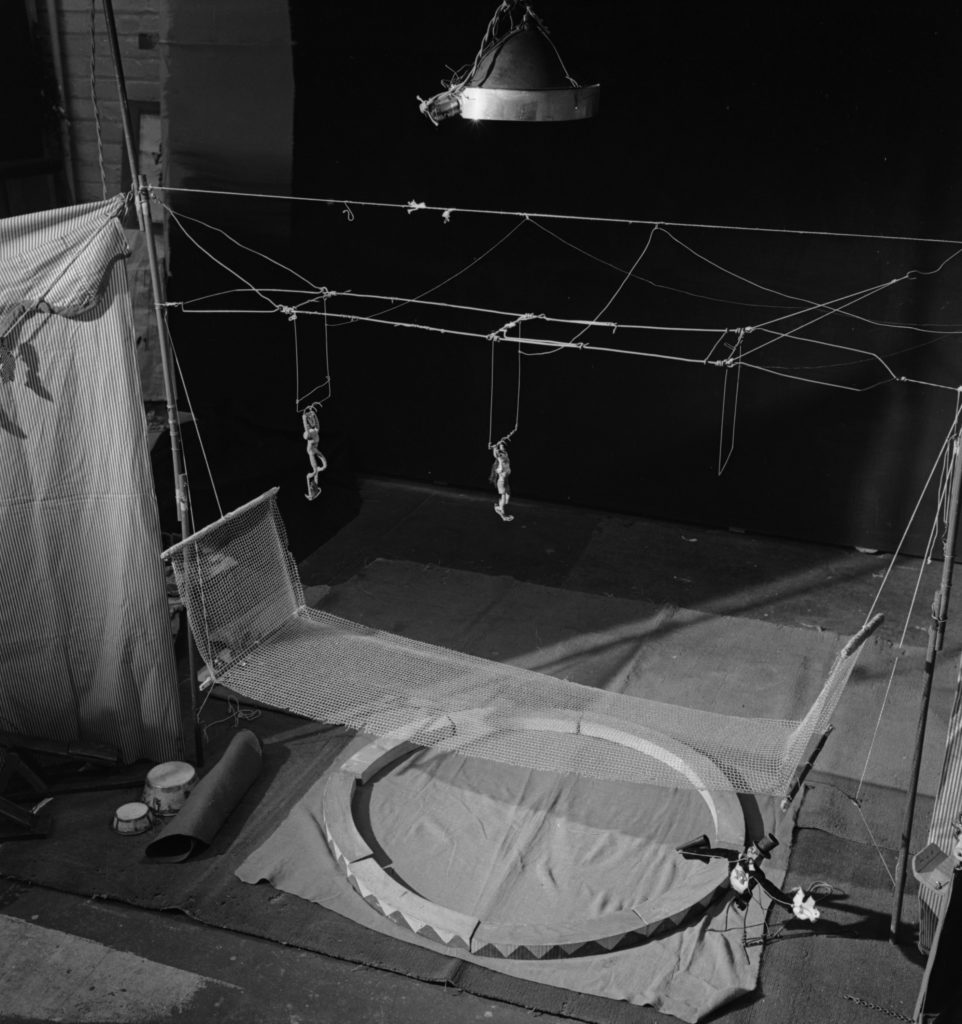
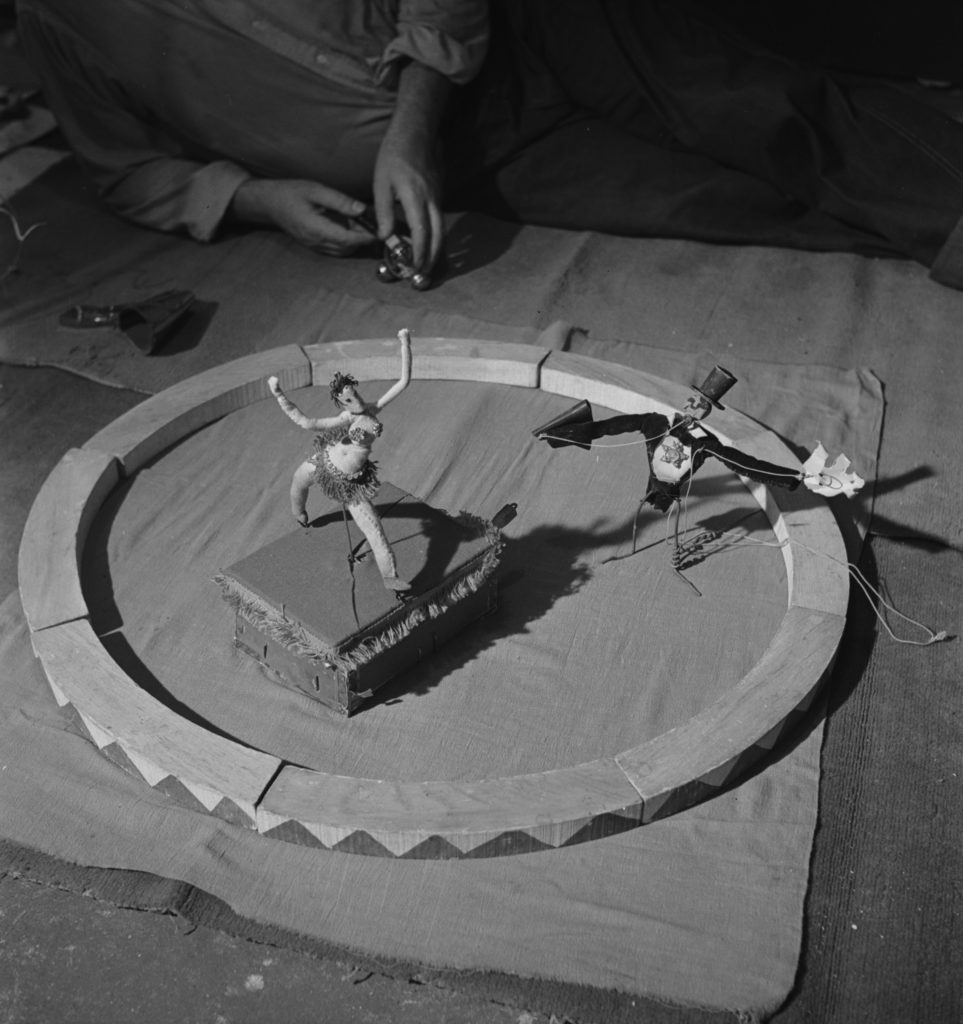
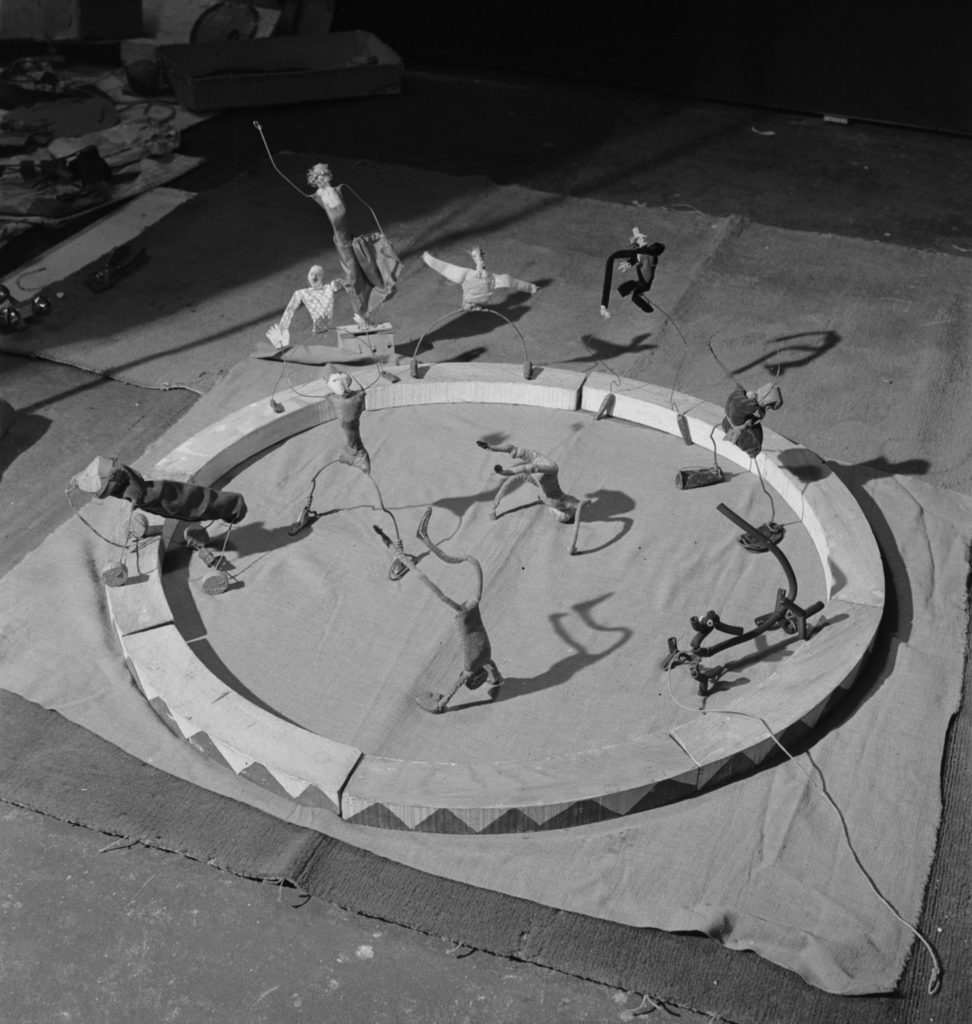
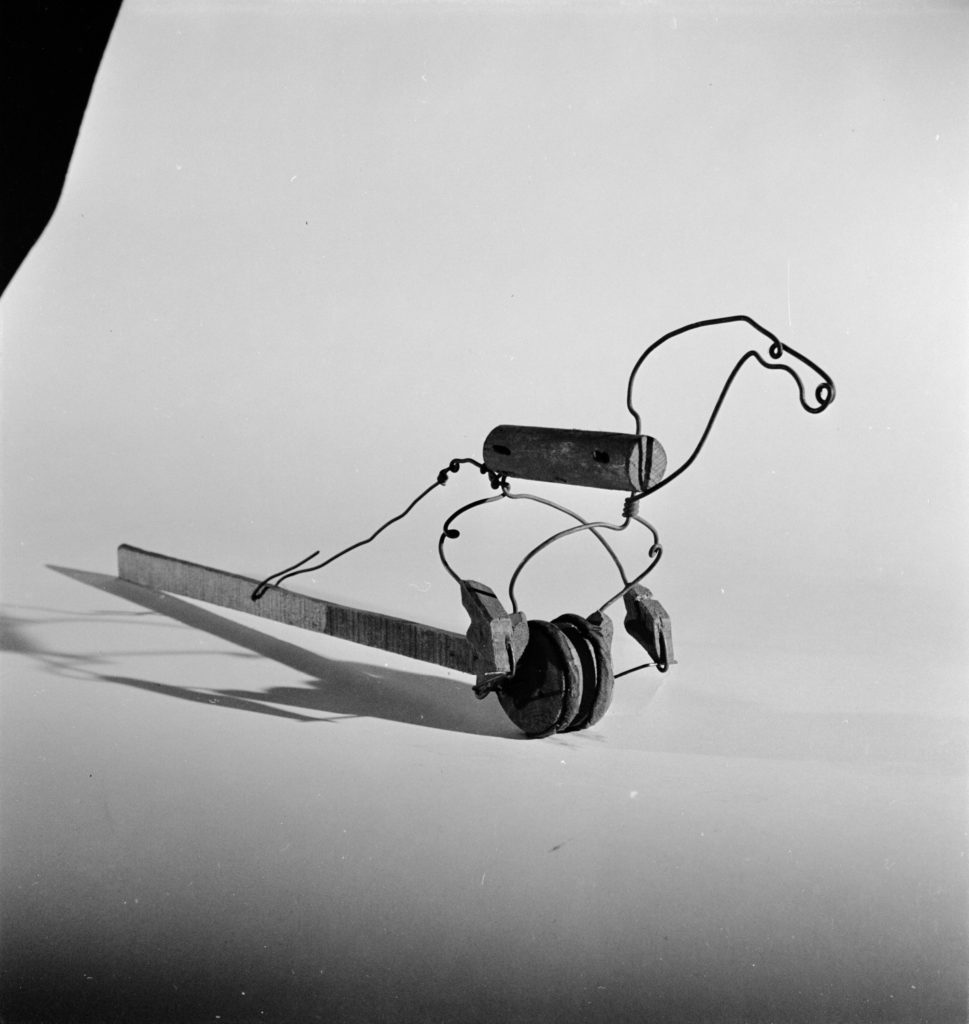
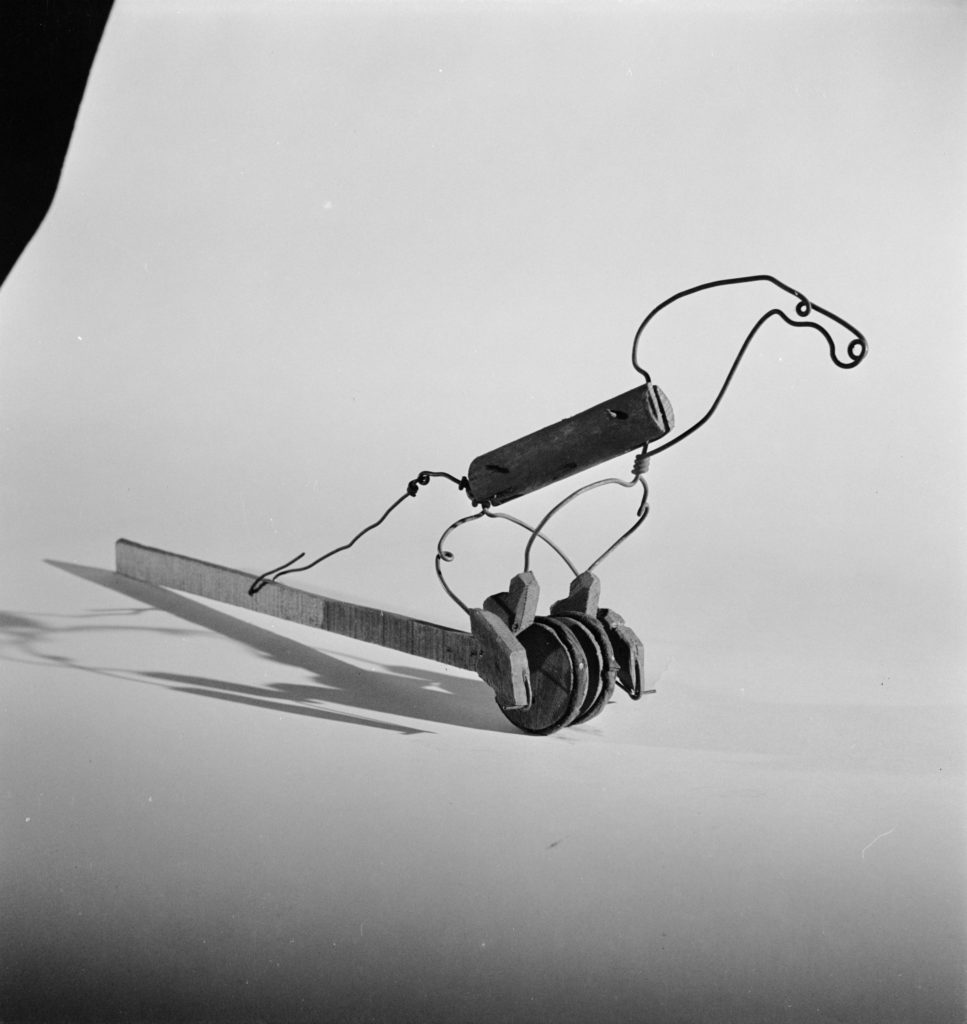

During his third year at the Art Students’ League, the idea of Paris began to attract him. In late June he signed aboard the freighter, Galileo, for Hull, England. He spent three days in London; then, on to Paris. The father of a schoolmate from Stevens was practically his only acquaintance there. When he arrived he knew no older artists—only a fellow-student or two from the League. But in the autumn he met the English engraver, William Stanley Hayter. Hayter introduced him to the sculptor, José de Creeft. And Calder took up his experiments in carving again.
Spring and summer of 1927 also saw the beginning of his famous miniature circus and the production of several animated toys which de Creeft got him to exhibit that spring in the Paris Salon des Humoristes.
At the beginning the circus was merely a few ingenious figures which Calder had made for his own amusement. There was nothing elaborate about them: bits of articulated wire for arms and legs and a wooden body—a spool, or a cork. Still their creator could make them perform some most remarkable feats. Gradually the troupe increased. Word got round Montparnasse. A casual turn or two to amuse a friend soon became a full-length performance.
The circus was given in Calder’s narrow room; the guests would crowd onto the low studio bed; the performance would take place on the floor in front of them. A bit of green carpet was unrolled; a ring was laid out; poles were erected to support the trapeze for the aerial act and wing indicators of the “big top”; a spotlight was thrown on the ring; an appropriate record placed on a small portable phonograph; “Mesdames et Messieurs, je vous présente—,” and the performance began. There were acrobats, tumblers, trained dogs, slack-wire acts à la japonaise; a lion-tamer; a sword-swallower; Rigoulot, the strong-man; the Sultan of Senegambia who hurled knives and axes; Don Rodriguez Kolynos who risked a death-defying slide down a tight wire; “living statues”; a trapeze act; a chariot race: every classic feature of the tan-bark program.
For the most part these toys were of a simplified marionette character. Yet they were astonishing in their condensed resemblance achieved almost entirely through movement. They were not mechanical. They had a living quality in their uncertainty. The dog might not succeed in jumping through the paper hoop. The bareback rider might not recover her balance. The aerialists might land in the net beneath, or might succeed in catching the swinging bars with their toes. The number of failures was uncertain; but an eventual success brought relief and restored equilibrium.
In turning to the circus Calder had adapted the time-honored tradition on which its performers based their routine. “Because the actual world, that in which we live, is a combination of movement and culmination, of breaks and reunions, the experience of a living creature is capable of esthetic quality. The live being recurrently loses and re-establishes equilibrium with his surroundings. The moment of passage from disturbance to harmony is that of intensest life … In a world made after the pattern of ours, moments of fulfillment punctuate experience with rhythmically enjoyed intervals … a world that is finished, ended, would have no traits of suspense and crisis, and would offer no opportunity for resolution. Where everything is already complete, there is no fulfillment.”[4] The circus had already taught Calder the esthetic of the unfinished, of suspense and surprise; it was on this he was to base all the most personal expressions of his later work.
In the spring of 1927 Marc Réal, a French artist, persuaded Legrand-Chabrier, one of the leading Paris critics of the circus, to visit Calder’s room to view a performance. Legrand-Chabrier was amazed and charmed, and left to write an enthusiastic column on it in Commoedia conveying brilliantly the quality of Calder and his circus. Réal brought Gustave Fréjaville, another equally famous connoisseur of the circus. Word got to Hugier, the third of a great critical triumvirate. The news spread. Mary Butts, the English author of Ashe of Rings, brought Jean Cocteau over from the Champs Elysées to the Left Bank. Ramón Gómez de la Serna, the circus authority of Madrid, and Sebastiá Gasch, the Catalan art critic, caught up the story. Pascin and Hermine David urged Calder without success to hold a gallery exhibition of his artistes. Foujita arranged an elaborate performance of the circus in his atelier. Even Paul Fratellini, the eldest of the three famous clown brothers, came. He expressed such admiration for a rubber-hose dachshund whose legs, constructed of spokes of uneven lengths, made it wobble as it moved, that Calder presented him with a large scale model, “Miss Tamara,” which Albert Fratellini led round on a leash in their act for several years.
The fame of Calder’s circus spread quickly between the years 1927 and 1930. All the Paris art world eventually came to know it. It brought him his first great personal success. But what was more important, the circus also provided the first steps in Calder’s development as an original sculptor. Some of his tiny circus performers and animated toys had heads of wire as well as arms and legs. A friend, Clay Spohn, a painter, suggested that he make a whole figure of wire. The result was his first wire sculpture, Josephine Baker.
This was a new development. The tiny articulated circus performers had taken a new scale and a new character. These figures were no longer merely toys wittily contrived from chance materials. They were now three-dimensional forms drawn in space by wire lines—much as if the background paper of a drawing had been cut away leaving only the lines. The same incisive grasp of essentials, the same nervous sensibility to form, and the same rhythmic organization of elements, which are virtues of a drawing, were virtues of this new medium.
Calder’s earliest figures in wire still retained a certain flat frontality. In fact, the Josephine Baker suggests a decorative approach in which a promise of his later jewelry is already evident. But Calder’s intuitive feeling for the possibilities of his medium quickly carried him into a convincing three-dimensionality. He began to mark essential planes by contour lines. He seemed to disassociate physical form from the completed mental concept of it. His figures were like peelings of form without weight or density. He made space intervene as a constructive factor. Through his naive approach he had hit upon a combination of draughtsmanship and metal construction that already had much in common with the open-form of the constructivists about 1920 and of individual researchers such as Lipchitz about 1927.
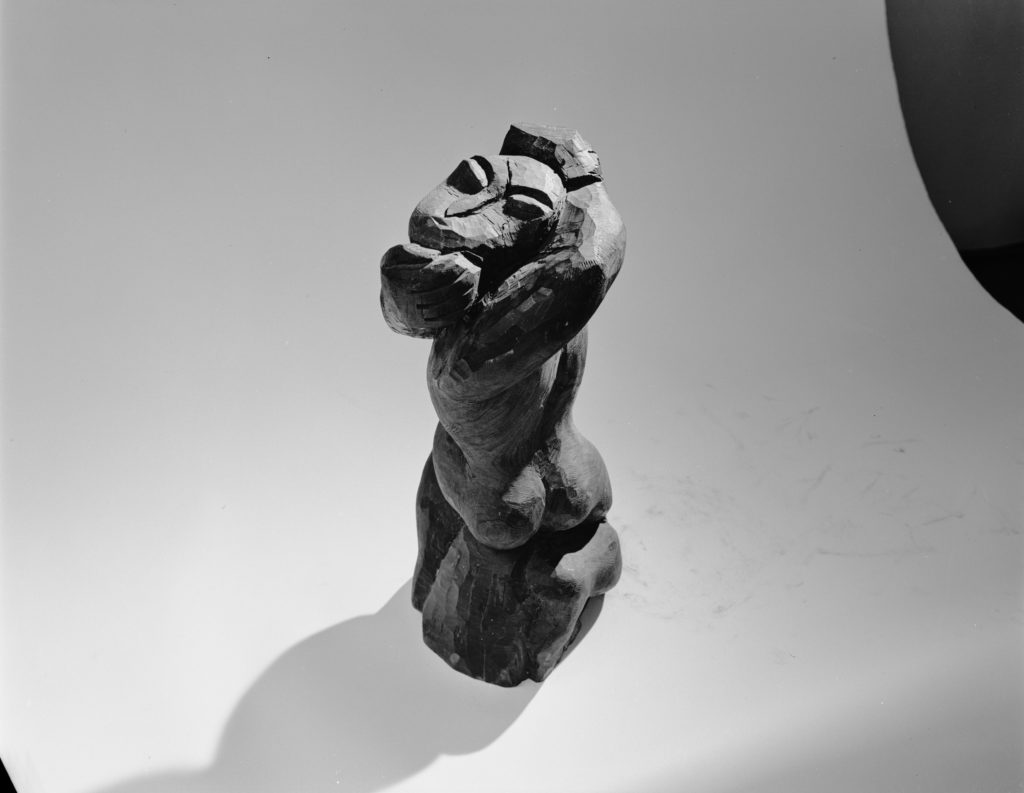
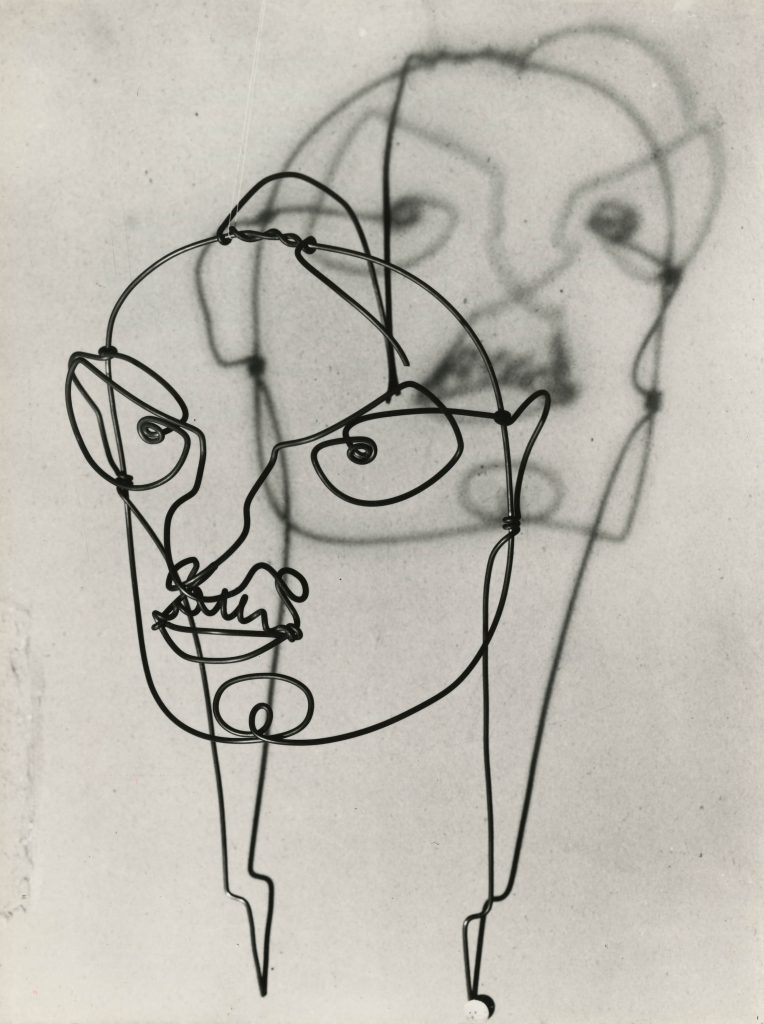
In April, 1928, Calder had his first one-man show, at the Weyhe Gallery in New York. This was made up principally of wire caricatures such as Helen Wills or The Hostess and caricatural portraits of many well-known public figures of the day. His technical ability had increased remarkably. But such calligraphic humor in wire was still difficult to accept for those who were accustomed to regard sculpture as an interpretation of mass. His father was interested and only gently critical. His personal viewpoint did not lead him to discourage an independent one in his son, no matter how foreign to his own aims the latter’s might seem to be. He liked to be able “to fondle sculpture.” His only objection to this wiry kind was that it lacked the appeal to the sense of touch.
The three-dimensional character of Calder’s wire sculptures, however, had developed steadily since his 1926 Josephine Baker. Possibly his experiments in wood carving, begun before leaving for Paris and now taken up with fresh enthusiasm, were a factor in this. In any case, the variety of woods, exotic and humble, which he has employed in his relatively limited wood sculpture production reveal his keen interest in materials. Both the texture and the form of a piece of wood appealed to him. They spoke to him and he followed their suggestions.
His first efforts at wood carving on his return to New York, in 1928, were mainly in low relief. But very quickly, as he allowed the natural form of a lump of wood to guide him, he developed a strong sense for three-dimensional conceptions as in Uncomfortable Face, Camel, or Cow. And the imagination with which he adapted the peculiarities of his materials was to provide an increasingly richer source of form from his austere Horse in weathered boxwood of 1928 through Shark Sucker down to his Martian fantasy, Apple Monster, in the late thirties.
A few weeks after the opening of his exhibition at Weyhe’s, Calder again caught public attention at the Independents in New York with his Romulus and Remus group, a fantastic ten-foot long, copper-wire she-wolf nursing a pair of wire youngsters from a row of pendent door stops. In November Calder left once more for Paris, to remain there until June of the following year.
Calder had now achieved a certain recognition, but primarily as a humorist. He had left painting for a form of wire-drawing in space. He had come to an easy mastery of this medium and in doing so had broken away to some degree from the conventional path. But he realized that wire sculpture had its limitations as an expression.
Up to this time his associations in Paris had been mainly among the less serious members of the Paris art world. He had arrived there knowing none of the leaders. Neither the croquis sessions of the Grand Chaumière nor the terrace of the Dôme had brought him much closer. The success of his circus and his wire sculpture in New York had come easily out of something natural to him. But in facing the problems of three-dimensional composition and the discipline of harder materials he had taken the first step in a new direction. The results, however, were not to appear until considerably later. Certain other factors had still to make their contribution; notably, a new group of associations in Paris among fellow-artists who were also searching for fresh ways to give the inherited traditions new life.
Before Calder’s return to Paris in November, 1928 a friend suggested that he should make the acquaintance there of the Catalan painter, Joan Miró, and promised to write him. One evening about New Year’s, when Calder was showing the circus to some American friends in his studio, Miró dropped in. Calder decided to repay the call and eventually found his way over to Miró’s studio in Montmartre. Most of Miró’s pictures were away at the time on exhibit in Brussels. There were only a few of his constructions in the studio—such as his 1928 Spanish Dancer, a feather fixed with a large colored pin to a bare cardboard ground. Calder “didn’t understand his stuff”; nevertheless out of this meeting grew a friendship that was to be very valuable to Calder during the next ten years.
Another afternoon Calder was sitting on the terrace of the Dôme with Kuniyoshi. Pascin happened by. Kuniyoshi introduced them. Pascin had seen Calder’s exhibition at Weyhe’s in New York and had liked it. The sensibility of the wire forms had appealed to him as a draughtsman. Calder arranged a small party shortly afterwards and invited Pascin. Hermine David was having a vernissage the same day. Pascin arrived from the vernissage bringing all present—about forty.
In January Calder had an exhibition at the Galerie Billiet. Pascin wrote the preface. The same month, in the Salon des Indépendants, he exhibited a new, over life-size figure, Spring, described by Paul Fierens as sculpture à claire-voie, or “openwork” sculpture. The Billiet exhibition proved Calder to be already an accomplished technician in a limited field. His ability to handle wire had brought him to an advanced point in open sculptural composition. His only serious fault was the frequency with which he still allowed the illustrator’s spirit and two-dimensional technique to dominate his work. But in portrait heads, such as that of Shepard Vogelgesang finished shortly before he left New York, a better balance between representation and structure had already begun to appear. And this newly acquired grasp of three-dimensional form becomes increasingly evident in similar portraits of Fernand Léger, Amédée Ozenfant, Kiki, the famous model, and others completed on returning to France.
In April, 1929 Calder exhibited some wood sculptures and wire caricatures in Berlin at the Neumann-Nierendorf Gallery. And during his stay in Berlin he made his first piece of jewelry for a woman painter, Chantal Quenneville: a collar with a projecting horizontal wire-beam from which a wire fly dangled.
On his return to New York Calder had an exhibition of wood and wire sculpture, paintings and textile designs at the Fifty-sixth Street Galleries. At the same time in an adjoining room was exhibited a private collection of eighteenth-century caged mechanical birds that twittered. That year Calder designed his first wire goldfish bowls, through which wire fish were made to swim back and forth by the turning of a tiny crank. Once again an animal rhythm had caught his eye. This time it was composed within a framed three-dimensional space. The result was a sort of music-box of visual rhythms. Its structure was still based on his articulated toys and circus devices. But now for the first time in his work we have a composition of movements bound to an immobile base, its primary purpose to satisfy an esthetic sense through rhythm. This was to be the basic principle of his mobiles three years later.
Since the spring of 1927 when Legrand-Chabrier first described Calder’s circus in Commoedia its reputation had constantly spread. Just before his return to New York he had given several farewell performances in his studio. Legrand-Chabrier again attended and again wrote it up even more enthusiastically. The troupe had practically doubled since he had last seen it. Fréjaville came, and Fuzier. And when Calder returned to Paris in March of 1930 all those painters who had not seen the circus, had heard of it and were at any rate inquisitive. Varèse brought Kiesler and Jean Painlevé to a performance one evening. Another evening, Kiesler brought Léger, the critic Carl Einstein, Théo van Doesburg and Mondrian. In those days Calder was still unfamiliar with such names. But a neighbor, an American abstract painter, William Einstein, was well acquainted with the researches and personalities of contemporary art. The evening Kiesler brought Mondrian, Einstein was in charge of the phonograph. He recognized Mondrian and afterward explained to Calder who he was. His enthusiasm warmed Calder to a visit to Mondrian’s studio.
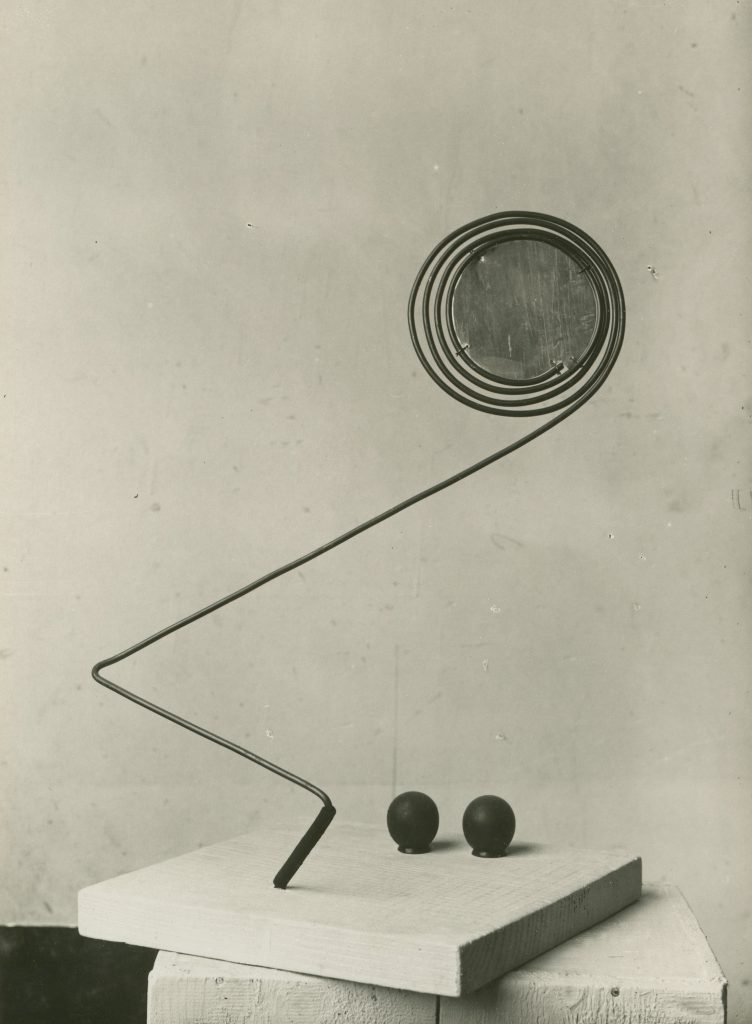
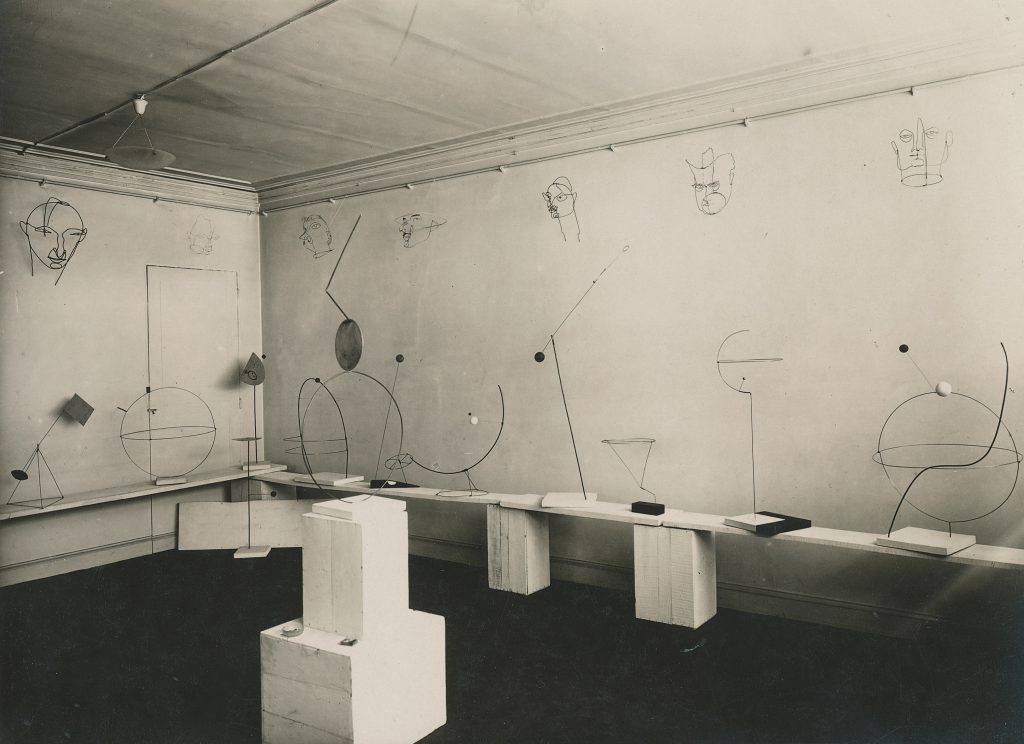
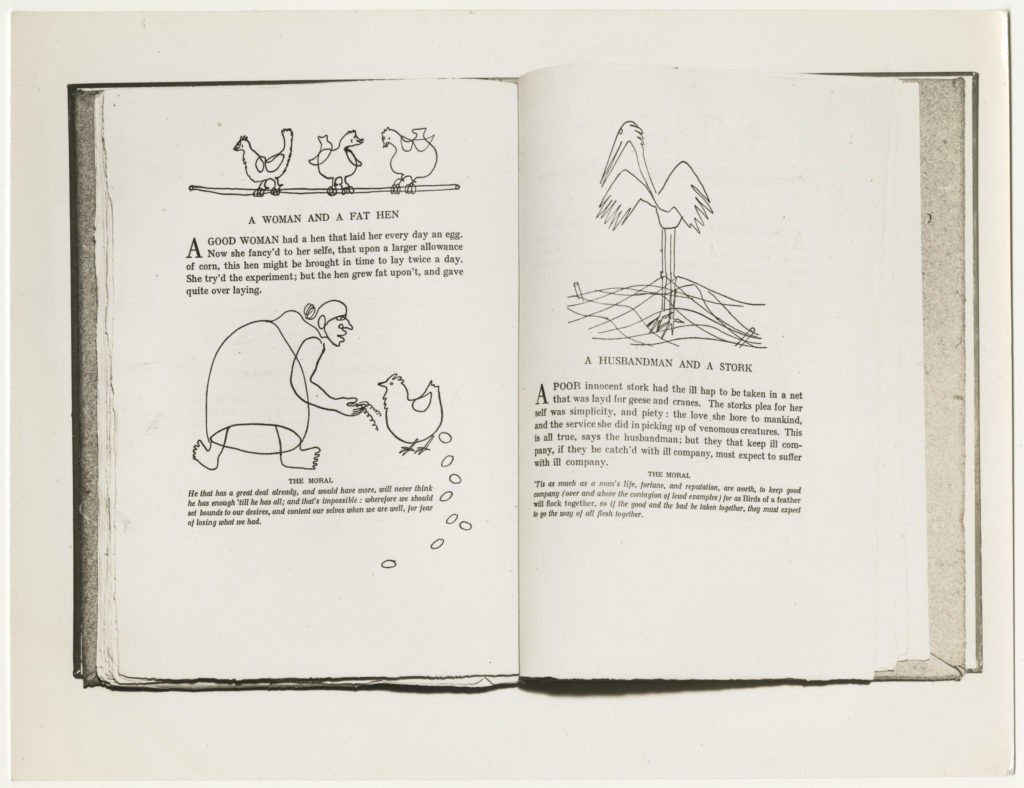
The visit to Mondrian was to mark the turning which led to all Calder’s most characteristic future developments. It was what gave him, as he described it, “the necessary shock.” Mondrian’s large, light, irregular studio was like one of his own pictures—or a spatial translation of one. The immaculate white walls were composed by removable rectangles of red, blue and yellow; the red cube of a phonograph accented the spacious calm of the central room. Calder afterward recalled how exciting the first view was to him, “with a cross light (there were windows on both sides), and I thought at the time how fine it would be if everything there moved; though Mondrian himself did not approve of this idea at all. I went home and tried to paint. But wire, or something to twist or tear, or bend is an easier medium for me to think in.”[5]
This revived interest in painting lasted barely three weeks. But from the character it took one sees at once the consequence of his encounter with Mondrian’s work, not a return to painting but a very evident turn from representational interests to abstract composition. And the step taken after this visit to Mondrian’s studio was never to be retraced. When Calder returned to Paris after his marriage in January, 1931, he began to broaden his acquaintances among the admirers of Mondrian. Through his compatriot, William Einstein, he met Hans Arp and Jean Hélion. Théo van Doesburg, the founder of the de Stijl group, had come with Kiesler the year before to a presentation of the circus. Now Hélion and Arp prevailed on Calder to join van Doesburg’s newly founded Paris group of nonrepresentational artists, Abstraction-Création. The interests of his new associates were quite different from those of his earlier Paris days. And when his exhibition at the Galerie Percier took place, we find him self-consciously apologizing for the inclusion of a row of some of his finest wire portraits which Mendes-France, the director of the gallery, urged him to show. On the back of a photograph of the exhibition Calder wrote: “Pay no attention to the portraits, the gallery insisted that I include them.”
The paintings Calder undertook after his visit with Mondrian were exercises. But the sculpture which was exhibited at the Galerie Percier shows a full assimilation of his experiences; “Simple things,” as Calder described them, “ranged on a plank against a wall.” But he is perfectly justified in stating: “In a way, some of those things were as plastic as anything I have done.”[6] It was to this type of stationary abstract sculpture that Arp, a few months later, gave the name “stabiles.”
Another consequence of Calder’s visit to Mondrian was the introduction of color into his sculpture. While draughtsmanship was an essential feature of his early wire sculpture, his new work had been obviously affected by painting. The tiny spheres and disks of the “volumes, vectors and densities,” as Calder described the objects in the Percier exhibition, were painted strong blues, reds and blacks. These showed up strikingly against the whitened wires and the dead white bases of the constructions.
To take such a step into the abstract field was an extremely serious departure for an artist in Calder’s position at the time. He had already established himself in the public mind as a humorist—a talented and witty one. He had built up a reputation and a certain patronage. Now those who had enjoyed what he had previously done so well were left completely at a loss. Fernand Léger wrote the preface to the Percier exhibition catalog. He opened his introduction with the question: “Eric Satie illustrated by Calder, why not? He is serious without seeming to be,” and closed with the statement: “Before these new works, transparent, objective, exact, I think of Satie, Mondrian, Marcel Duchamp, Brancusi, Arp; those incontestable masters of reticent and silent beauty. Calder is of that line. He is an American 100%. Satie and Duchamp are 100% French. Yet we meet.” Some critics picked up Léger’s line in the catalog introduction, “he is serious without seeming to be.” They asked, why be serious if this is the result when it is so easy for Calder to be gracefully amusing? Others who knew him only as a humorist, felt this was merely some elaborate joke. But the effect of Mondrian’s work had made up Calder’s mind. He had half-consciously felt that his representational work in wire had its limitations. When he saw what Mondrian had achieved, he realized how close to convention his naturalistic and caricatural drawings remained even when translated into wire. Abstract composition was the field he had been looking for. To enter it he would have to leave the other behind. Those who enjoyed his earlier work might follow him if they cared to. It was not for him to stay with them.
Still the naturalistic draughtsman in Calder was by no means superseded by the abstract constructor. In the summer of 1931, he produced some of his finest graphic work and a masterpiece of American book illustration, the Fables of Aesop for Harrison of Paris.
In the Galerie Percier exhibition Calder had not yet undertaken to incorporate movement into abstract design. But to realize his original idea, that Mondrian’s rectangles ought to be made to oscillate or vibrate, Calder had available all the technical experience of his animated toys and circus devices. His 1929 mechanical goldfish bowl had since led to several other variations of the original. For them he had worked out a technique of simple mechanical devices for controlling a patterned rhythm of moving objects within a fixed frame. Now he again took up the problem of motion. At first he limited himself to a slight rhythmic movement in a single object fixed to a base. Then the idea struck him of making “two or more objects find actual relations in space.”
This was the first feature of his new approach: the organization of contrasting movements and changing relations of form in space. This was also the point at which Calder went beyond anything the Russian constructivists had realized in mobile sculpture. For Gabo’s Kinetic Sculpture of 1920 offered only the rhythmic swing of a single erect element—a weighted flexible perpendicular, fixed to a base. In Calder’s mobile sculptures of 1931, small spheres of different sizes painted in contrasting primary colors were moved up and down thin curved wires at contrasting rates of speed, as in A Universe, 1934. Various geometrical shapes were made to turn rhythmically about creating constantly changing relations of forms. Some of the constructions were driven by small electric motors, others were moved by tiny hand cranks.
The shapes employed were still strictly geometrical, like those of his stationary abstract arrangements of the Galerie Percier exhibition. In his work of this period he had put aside organic forms as completely as the constructivists had. But for all their geometrical forms and mechanical movements these new constructions had a living quality and spirit of humor about them that went back to the wit and observation of his wire sculptures and the gaiety of his circus and animated toys.
In these new constructions Calder had managed to give abstract forms the movements which he had mimicked from nature in his toys. The surprise and charm of his circus performers and toys lay in their striking truth to characteristic human and animal movements. This was the source of life and variety in their rhythms. In the toys he had parodied a duck dragging a recalcitrant worm out of the ground: now in the mobiles the hammer motion of the duck’s head and beak was reduced to the simplest form of mechanical movement. He had begun with natural movements—the galloping of a horse, the seductive wriggles of his Oriental dancer, the frenzied trot of the circus stretcher-bearers—now he was dealing with motion not in any representational frame of reference, but for its own sake. Form had been reduced to its geometrical bases, motion had followed suit. Calder felt that to combine two or more simple movements with contrasting rates of speed gave the best effect because, while simple, they are capable of infinite combinations. He had left synthesis for essence; he had come from the naturalistic to the abstract. Still these movements had kept a liveliness and variety, perhaps due to the fact that their indirect inspiration was a caricature of nature not the bare rhythms of a machine.
And, as a consequence of this underlying parody of human and animal movements, these machines had, perhaps, a closer relationship with dada and futurism than with constructivism. The resemblance between Calder’s Galerie Percier “volumes, vectors and densities” and early constructivist work was evident. But while constructivism was a calculated, unemotional expression, dada was a laughing iconoclasm based on the belief that a healthy art could only flourish if the conventional trappings and false seriousness of art were stripped away. Dada was an outgrowth of Italian futurism. The futurists had preached the importance of incorporating movement as an esthetic factor. Art had too long been static. The modern world was a world of movement. Modern art should embody it. Duchamp and Picabia, in their interest in the representation of movement and the satirical use of machine forms, effected a link between futurism and dada in such work as Duchamp’s The King and Queen Crossed by Swift Nudes and Picabia’s The Infant Carburetor. The spirit of Calder’s new machines was certainly closer to such work than to that of the Russians. His humor was more genial. But humor took the place of subject matter with Calder, just as a less innocent type of humor was that of the dadaists. The link becomes even closer in the term, “mobile,” which had perhaps its first esthetic application about 1917 in Duchamp’s notes for La Mariée mise à nue par ses célibataires, même. And when Calder, shortly before the Galerie Vignon exhibition, asked Duchamp to suggest a name for the new constructions Duchamp without hesitation proposed “mobiles.”


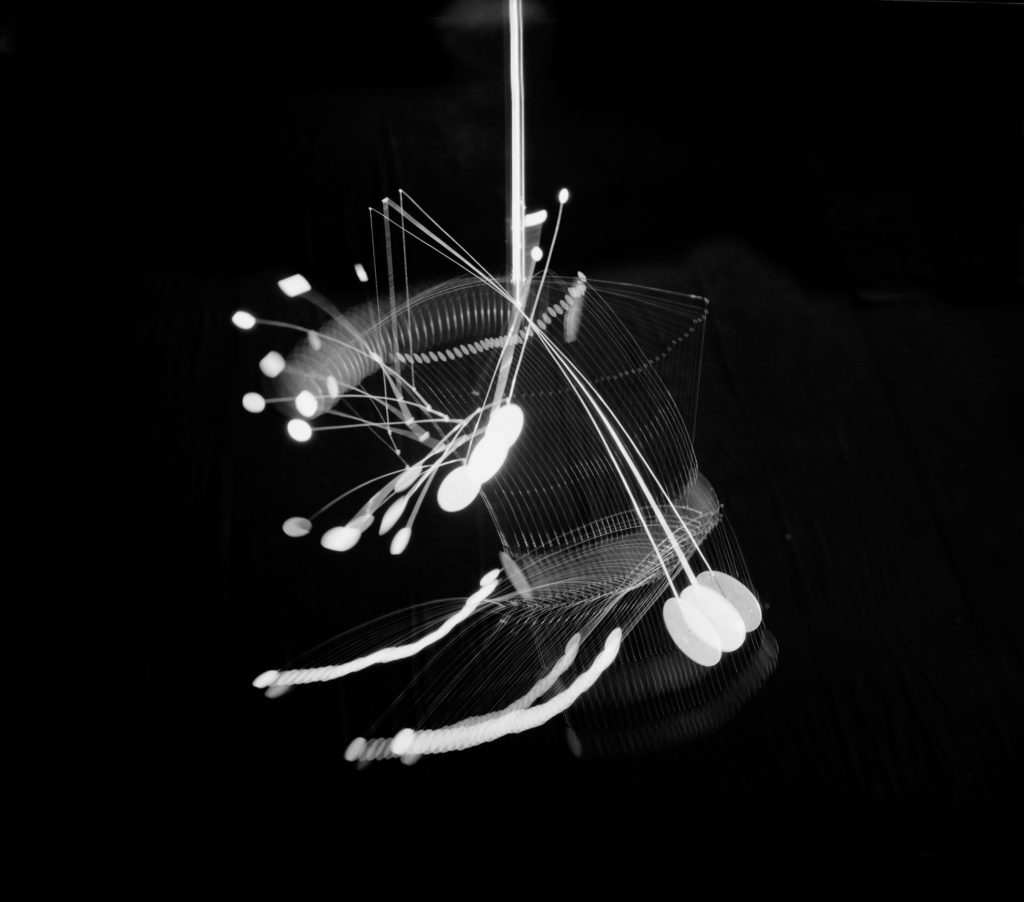


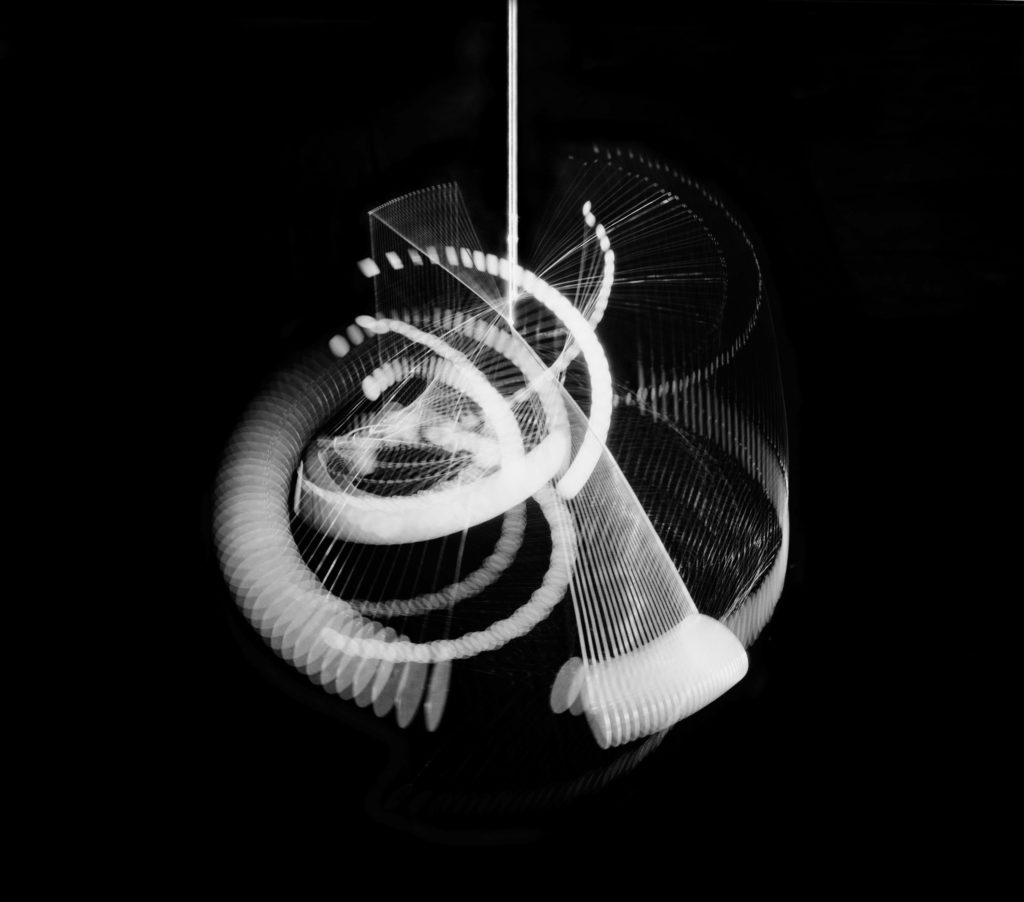
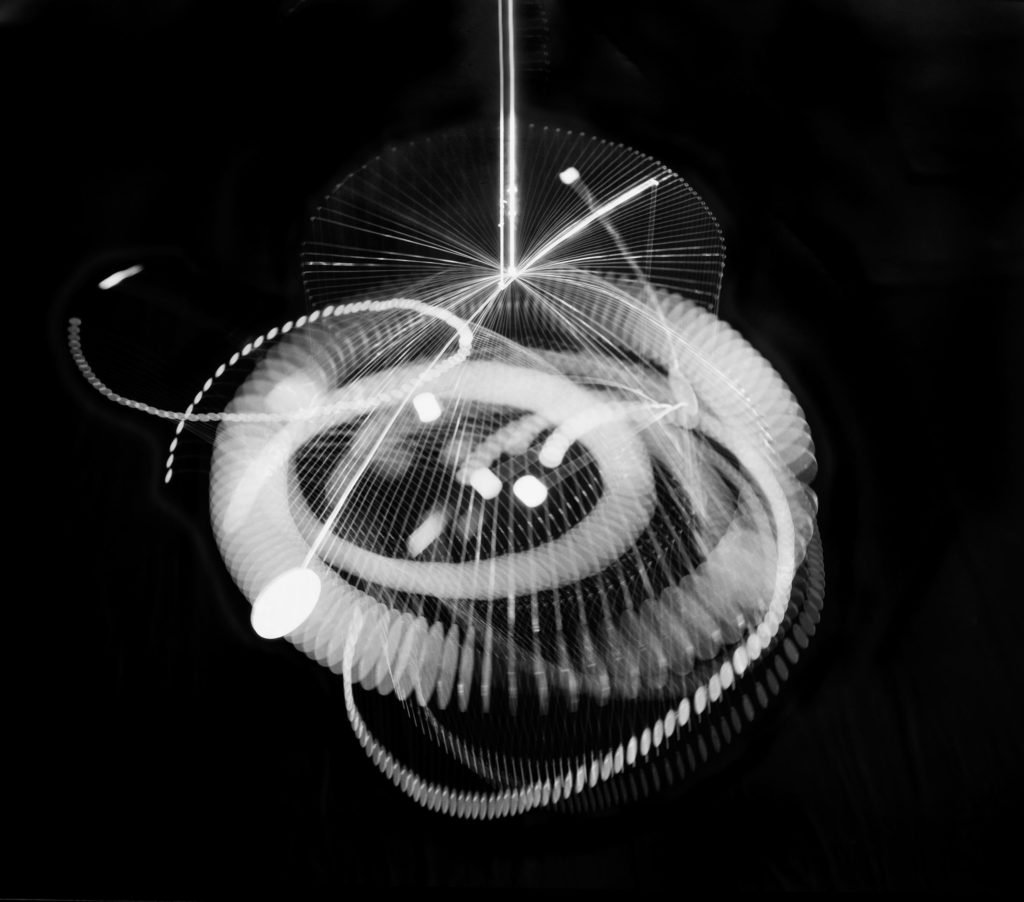
Such motor-driven or hand-cranked mobiles had the advantage of a power to control their performance and superimpose movements in the fashion of a ballet’s choreography. This, however, meant a set pattern. And Calder soon began to feel it a restriction: without complicated mechanisms, such controlled patterns ran the risk of becoming monotonous in their repetitions. A free natural movement would be more desirable in many ways. What might be sacrificed in formal patterns, would be made up for in rhythmic variety. Unpredictability of movement would give a greater sense of life. Chinese wind bells were made to please the ear with their tinkling tunes by a gust of air. Why should the wind not be enlisted to please the eye with rhythmically swinging sculptural forms—and for that matter to entertain the ear with their jangling?
The result was Calder’s first wind mobile, begun shortly after his Galerie Vignon exhibition. And this was the principle on which most of his future mobiles were to be based. It is true that some of his most ambitious motorized mobiles, the White Frame and the Black Box, were produced in 1934 and 1935. Still his motorized production after 1933 was principally limited to colored wall panels against which various forms were made to describe rhythmic patterns (Little Blue Panel and Orange Panel). With his wind mobiles movements and rhythms became more relaxed, more free—took an air of spontaneity. Little by little, chance began to play a larger part in their rhythms—eventually even in their constituent elements.
Perhaps this reawakening of fantasy came out of a closer intimacy with Miró. Their friendship had grown steadily since their first meeting; and Calder’s difficulty in responding to Miró’s painting had long since disappeared. Miró at the same time had become an enthusiastic admirer of Calder’s work. In August, 1932 Calder returned to Paris by way of Spain and visited Miró on his farm at Montroig, near Barcelona. The following January at Miró’s suggestion Gomez de la Serna, Spain’s leading circus critic, invited Calder to Madrid to present his circus during an exhibition of his work at the Residencia de Estudiantes; and Miró arranged an exhibition for him through the Amics de l’Art Nou in Barcelona. Later that spring Calder exhibited with Miró, Hélion, Pevsner, Seligmann and Arp at the Galerie Pierre in Paris. Miró’s work at that time had probably touched its most abstract point. And we can recognize a definite affinity between the forms in Miró’s and Arp’s work of this period and Calder’s which has had persistent echoes in his work even to the present day. Miró had long ago broken with the surrealist group. His fantasy, however, had by no means dried up at the separation. And Miró’s fantasy as well as his sly, gnomish, yet robust humor had come to appeal very deeply to Calder.
It is likely that this new interest in chance rhythms and chance forms on Calder’s part owed much to Miró. However, it is obvious from Calder’s earlier approach to wood carving that he could scarcely hold happily with Mondrian’s creed: “In the new art, forms are neutral … The new art effort suppresses the subject and the particularized form.”[7] The richness of natural forms meant too much to him. His late severely geometrical forms had taken first a freer modeling; then little by little calculated forms gave way to forms suggested by the material—a lump of wood, a piece of bone—till finally the materials employed seemed scarcely touched by tools. At the same time, chance rhythms had come to supplant patterned rhythms. By 1934, the novice stage of his work was over. The geometrical cycle opened by the shock of Mondrian’s studio was completed. The organic cycle was now beginning; and with it a search for new suggestions from new materials for both static and mobile sculpture, and for a new sculpture in space.
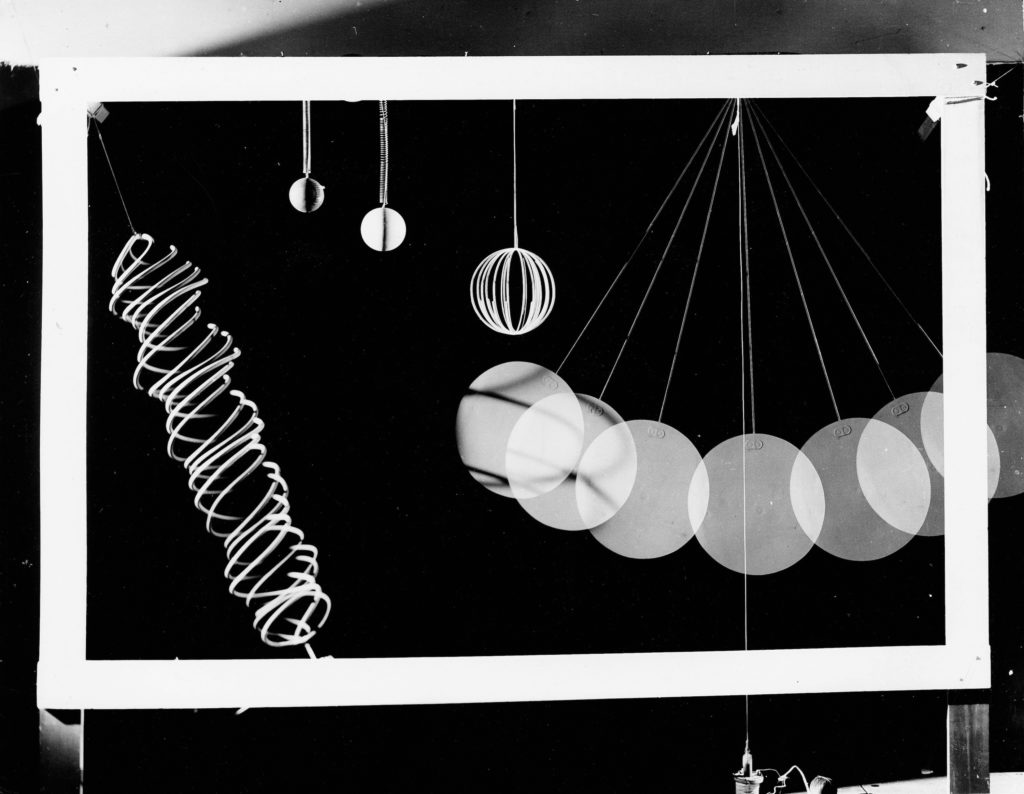

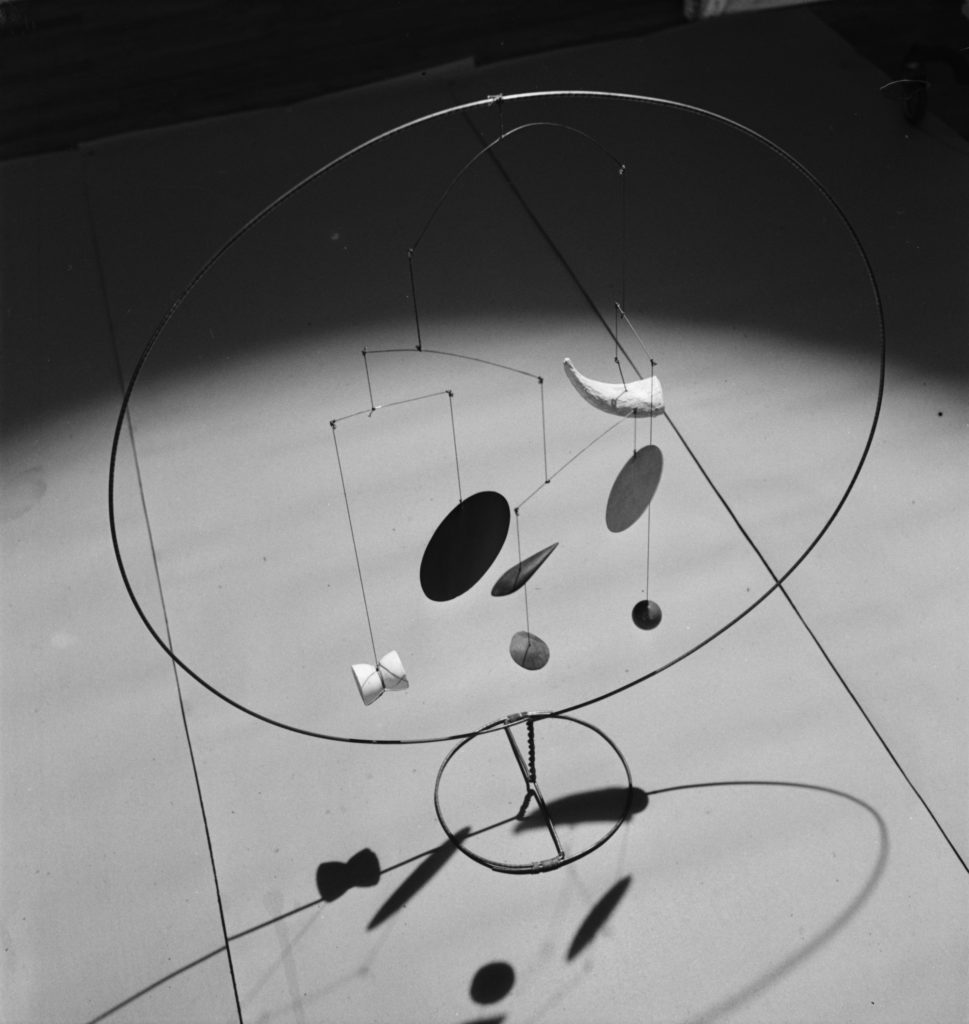
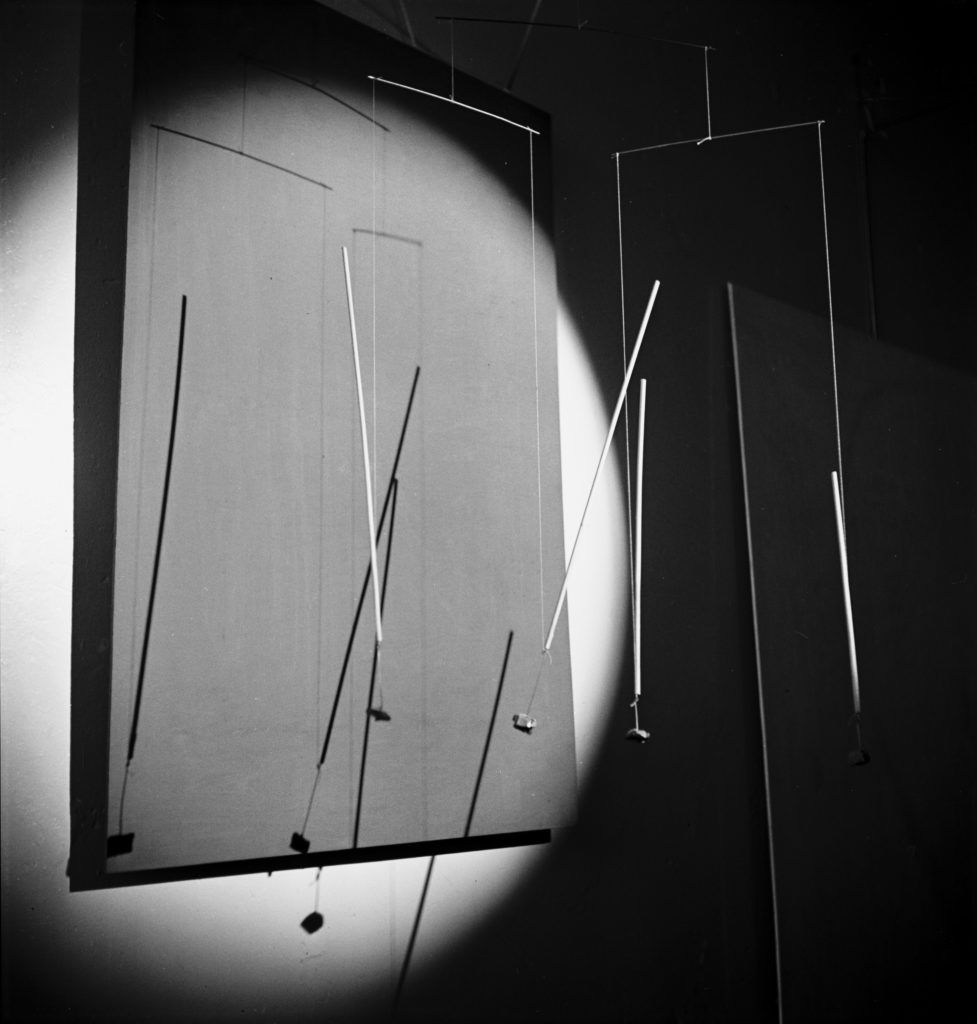
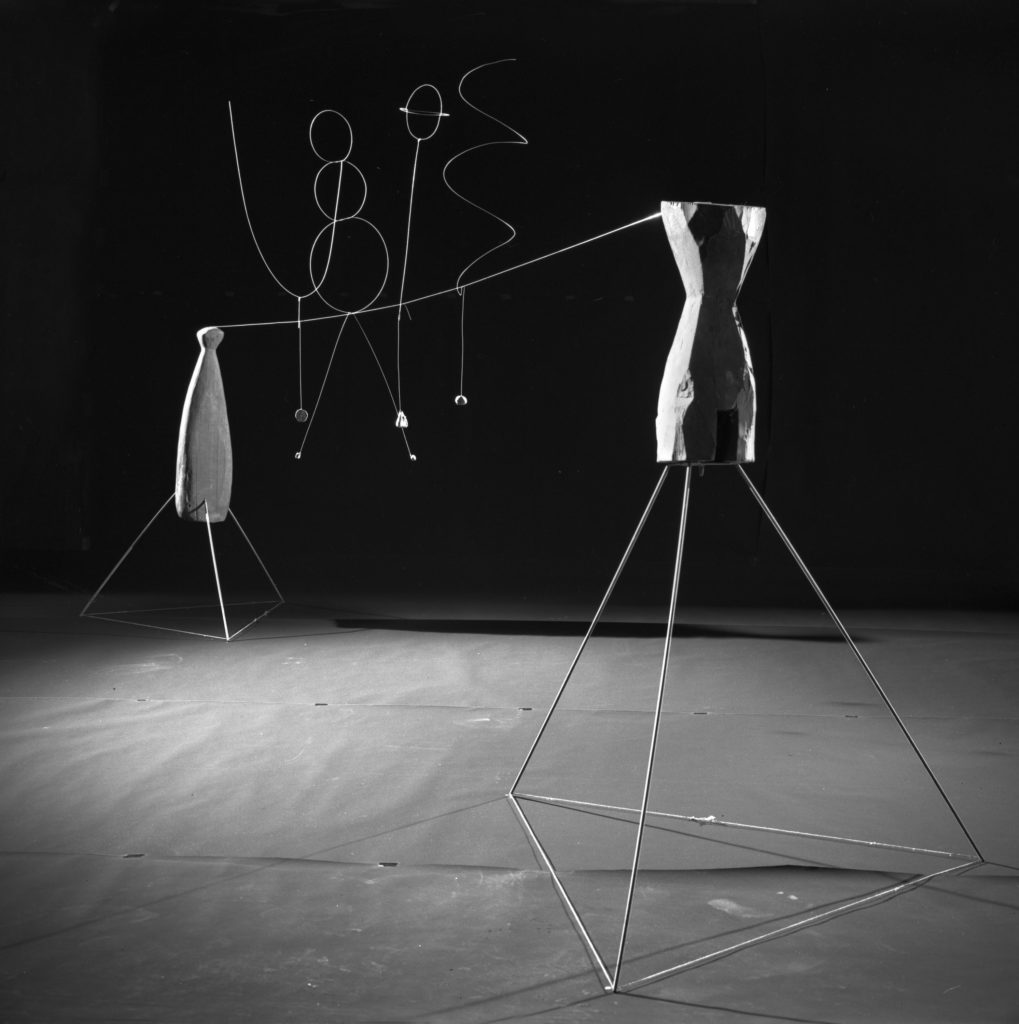
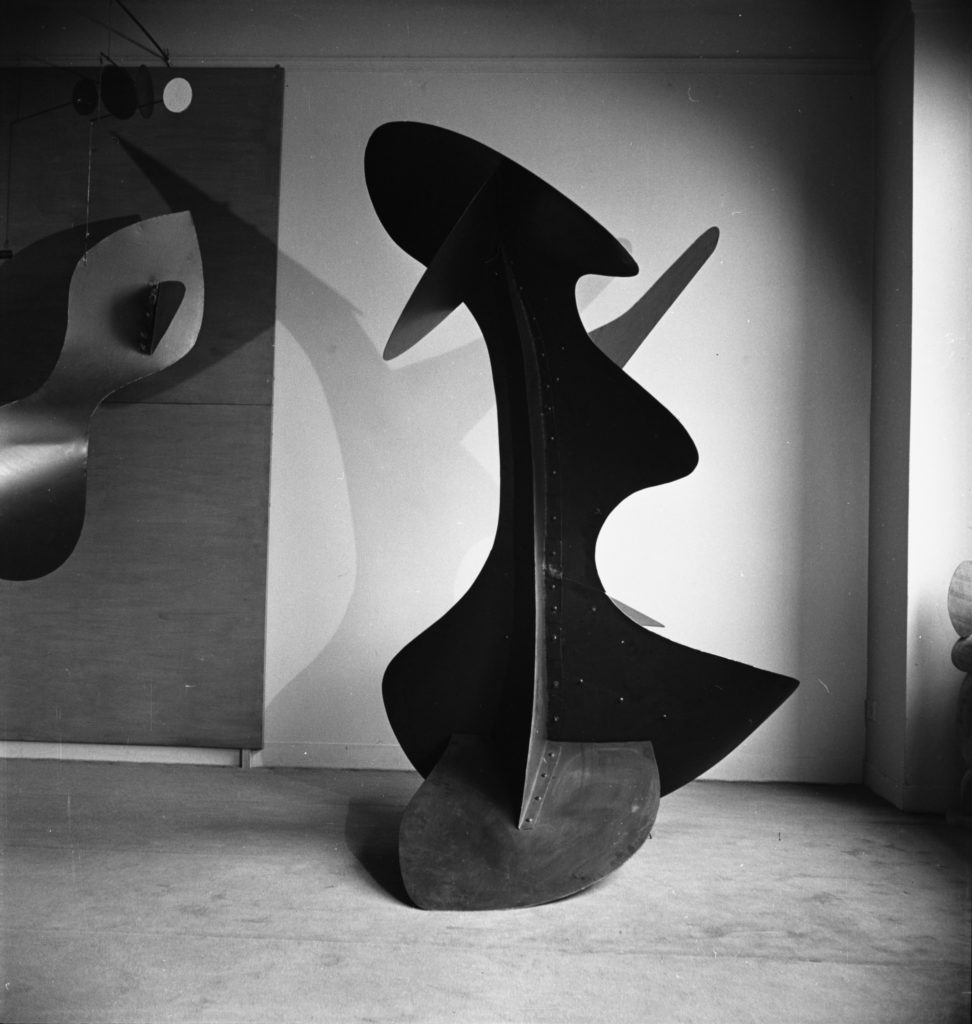
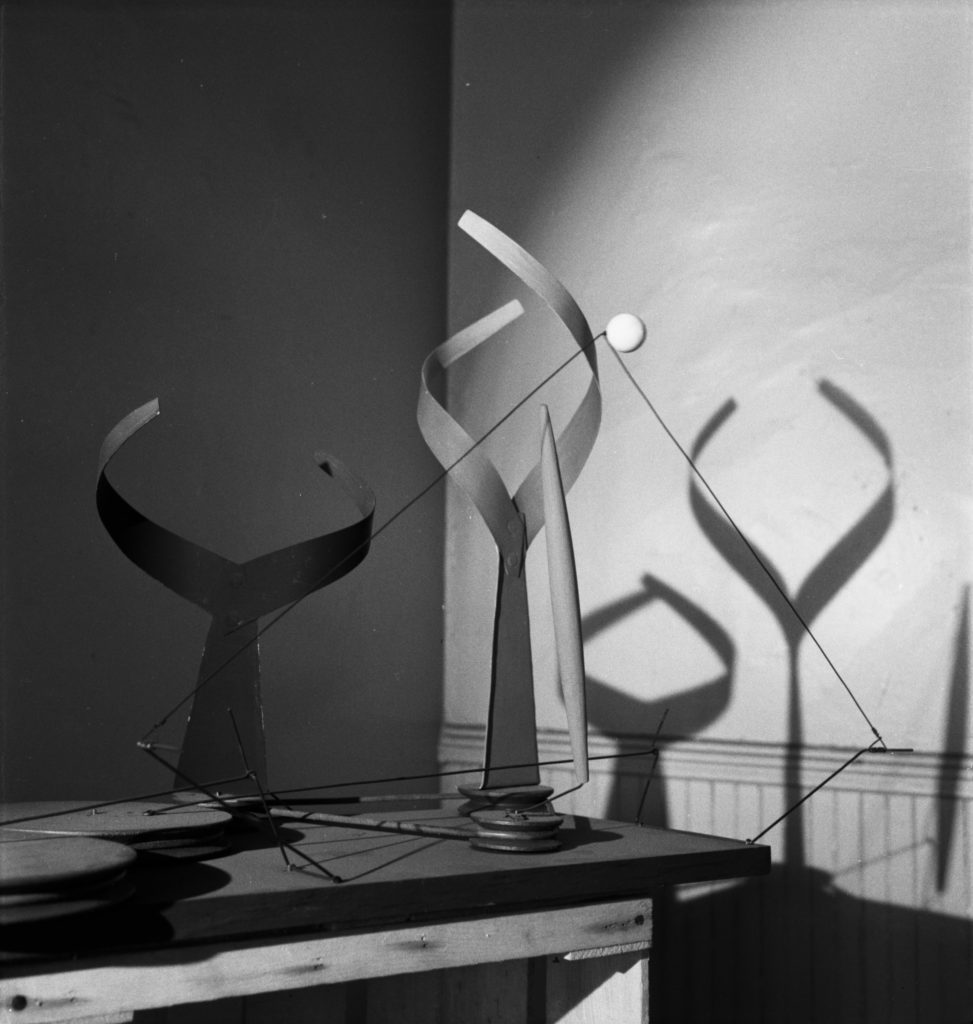

Up to this time Calder’s work had been intimate studio expressions. With the return to the United States in the summer of 1933 there began to develop a feeling for increased scale. The confined studio quarters of Montparnasse had given place to the open countryside of Connecticut. The dimensions of his sculpture seemed to respond to the scale of his new environment.
Before leaving Paris Calder had produced a large motorized composition entitled the Red Frame. Its size and construction made it difficult to ship. But shortly after settling in Roxbury he produced another composition along the same lines, White Frame, the largest motorized mobile he had yet realized. And the same year, 1934, saw his first outdoor mobile, Steel Fish, set up on the hill behind his farmhouse at Roxbury.
On first abandoning mechanical rhythms for free rhythms he had tended to see his forms as two dimensional compositions, for example, the Calderberry Bush, 1932. But just as Calder’s wire sculpture, predominantly two-dimensional at the outset, came to suggest transparent volumes, such large-scale, free-swinging mobiles as the Steel Fish now began to describe, with gestures like a dancer, volumes in space. These are most graphically recorded for us by multiflash photography.
In realizing these gesture compositions of virtual volumes through his mobiles, Calder had carried the transparency of his early wire sculpture beyond the transparency of the constructivists’ work. And in hanging his mobile elements free, he had given them a far greater opportunity “to find actual relationships in space” than he had provided in his most ingenious motorized mobiles of the Galerie Vignon.
Calder’s love of the spectacular had always been keen. This was evident from certain features of his circus and such a tour de force as Romulus and Remus. In 1935 and 1936 Miss Martha Graham recognized the dramatic possibilities of his mobile panels and had several enlarged to serve as “plastic interludes” during the performances by her dance group at Bennington and in New York. In 1936 he also fulfilled Fernand Léger’s query of 1931 “Eric Satie illustrated by Calder, why not?” by designing a setting for a production of Satie’s Socrate at the Wadsworth Atheneum in Hartford.
At the same time, during these years, 1933 to 1937, Calder was consistently extending his interests in unconventional materials and unusual uses of familiar ones. The contrasts of porcelain, wood and metal in The Circle had led to similar oppositions of material in free-swinging mobiles. String, though perishable, allowed a greater freedom of movement than wire. Rough wood was contrasted with carefully planed wood forms, dainty spheres and disks of metal. Heavy crudely-cut blocks were contrasted with light wire figures that danced at the slightest breath of air. Glass and polished metal were exploited for their luminous effects.
The conscious avoidance of technical “finish” in Calder’s work was always one of its qualities. In his sculpture it offers an equivalence to the nervous quality of a line in drawing. The larger lines of the total form provide the discipline or framework. This is always carefully worked out and respected. Within it the rough, unfinished elements provide a detail interest—a subordinate textural variety which gives a living quality to many of the materials he employs which, if “finished,” would have no life. This “unfinished” quality within a dominant structural unity is the formal equivalent of the recurrent failure of his circus performers to achieve their feats—the equestrienne to recover her balance on the horse’s back or the aerialist to catch the swinging bar. But these rough effects, like the circus performers’ failures, must eventually be tied together by the satisfaction of the main form. They provide the features of “disturbance” out of which harmony is resolved in the main design.
There was, however, some danger that his often casual technique and lack of “finish” might be carried too far. But now Calder’s new work at larger pieces after his return to the United States required greater technical care. This in no way conflicted with his maintenance of a lack of “finish,” where such a lack was a quality. The increase in scale merely made it necessary to pay greater heed to structural problems.
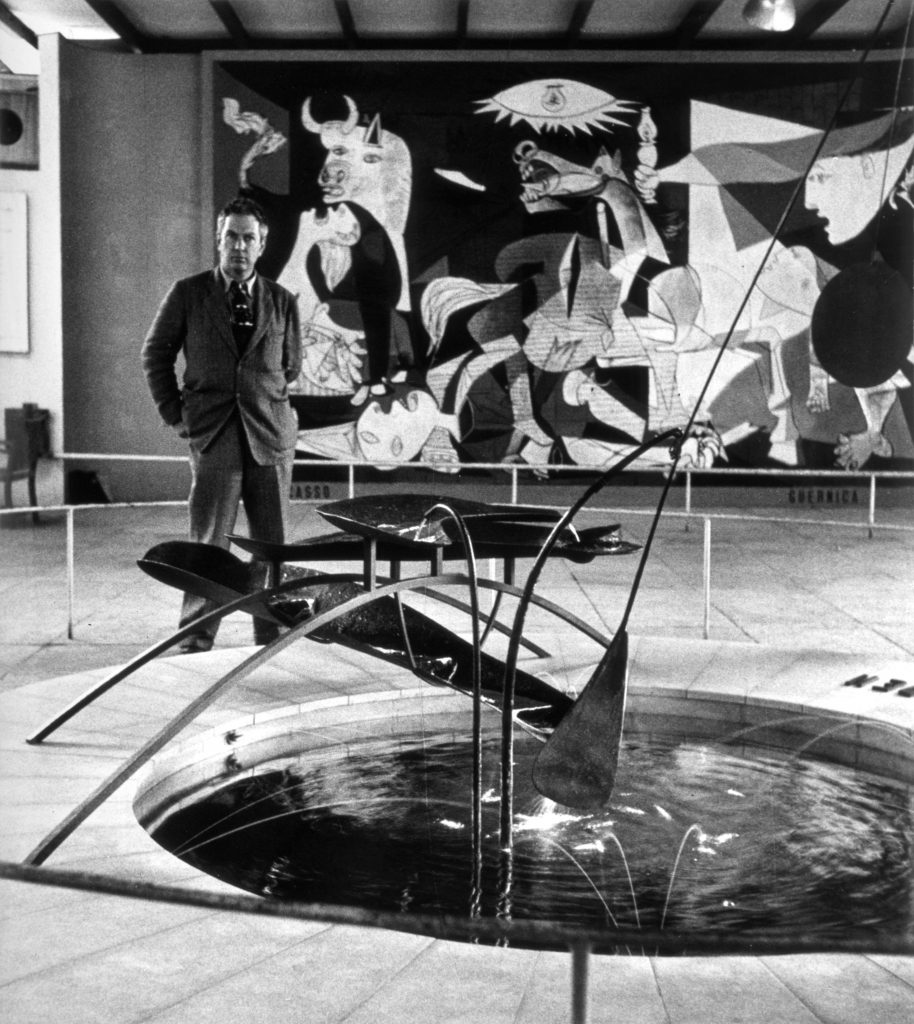
In April, 1937 Calder returned to France for a visit. Paris, at the time, was in the midst of preparations for its Exposition of that year. An opportunity on the Exposition grounds gave Calder a chance to draw full advantage from his three years research in large-scale sculpture in the United States and his increased knowledge of showmanship.
Miró and Picasso were preparing mural decorations for the Spanish Pavilion. Miró had introduced Calder to the architects of the Pavilion, José Luis Sert and Luis Lacasa. One of the principal Spanish exhibits was to be mercury from the mines of Almaden in the southwest of Spain, one of the important objectives of Rebel attacks at the time. A fountain which would spout mercury was being constructed in Barcelona. But from photographs sent from Spain the architects felt it would neither harmonize with the Miró and Picasso murals, nor with the architecture of the Pavilion. Sert who knew Calder’s work and admired it suggested that he design another to be used in its stead.
The result was one of the most outstanding successes of the Exposition. Unaware of the artist’s nationality. André Beucler, the author of a comprehensive review of the Fair in the Arts et Métiers Graphiques wrote:
In this field of plastic expression, Spain has realized a masterpiece: the mercury fountain. The exploitation of the mercury of Almaden is an important industry for Spain. There would have been many ways to make this theme tedious. They could have explained the nature of this metal, its properties, they could have exhibited it with all the trappings apparently due to precious things (as was done for the Belgian diamonds) but, true artists, the Spaniards concentrated on one thing only: on the beauty of the mercury in its mysterious fluidity. The architects of the Spanish Pavilion, L. Lacasa and José Luis Sert therefore designed a fountain, a simple basin, in the center of which a strange construction of black iron, graceful and precise like a great insect, allowed the mercury to flow slowly, to collect itself into a mass, to scatter, to roll from time to time in melting pearls, to play perpetually by itself, to the delight of the public which was present for the first time at the delicate spectacle of mercury moving in a fountain.[8]
In concluding the writer adds, “It should be observed in this connection the powerful attraction which every animated presentation exercises on the public.”
Glass and polished steel, Calder was told, were the only materials which would withstand the corrosive effects of mercury. Neither satisfied him. Neither afforded sufficient color contrast to the mercury. But the concrete basin for the fountain was lined with pitch. Pitch, then, would resist corrosion. And pitch afforded the greatest possible color contrast to the mercury: the metal structure was painted black and lined with pitch.
Due to the weight of the mercury and the loss in splashing, Calder was allowed to spill it only from a height of little more than a yard. To give the whole design more height and to introduce a further element of mobility Calder hung a rod vertically from the top of the structure by a ring at its center of balance. The lower end of this rod was widened into a plate of irregular form and was set so that the stream of mercury leaving the chute would strike it and cause the rod to sway. From the upper end of this rod a lighter, free-swinging rod was hung; at its tip was suspended the name of the mines, Almaden, in brass wire.
The Mercury Fountain was a key point in the evolution of Calder’s art. Here all the important threads of his work up to this point were drawn together. The spirit of play won the public to it as to a glorified mechanical toy. It had a technician’s structure, in which both the engineer and the artist in Calder collaborated. Movement and the changing relations of form in space were there; new effects through new materials; an outdoor scale; a fixed construction to which a mobile arm related the lines and forms it described by its movements. All were bound together in a three-dimensional unity of open form over the circular, concrete basin: an ambitious and deeply personal realization. With it Calder achieved the first full mastery of his new idiom. He now had the assurance to speak out boldly in the future.
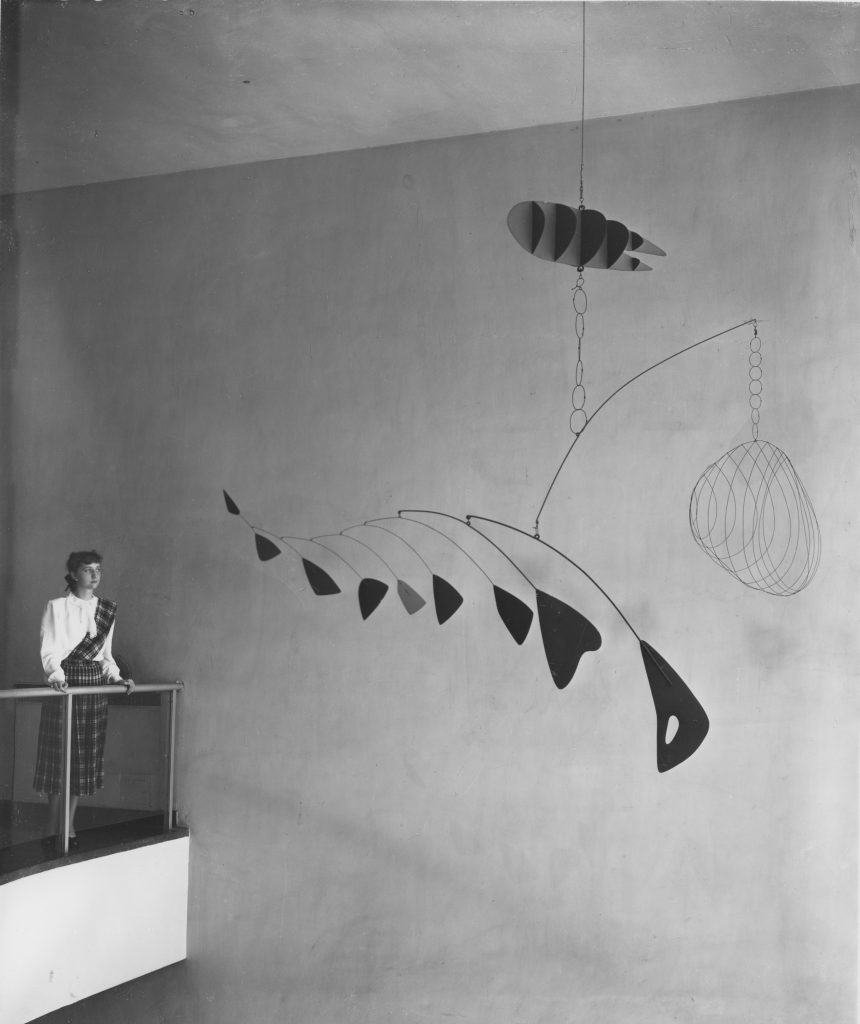
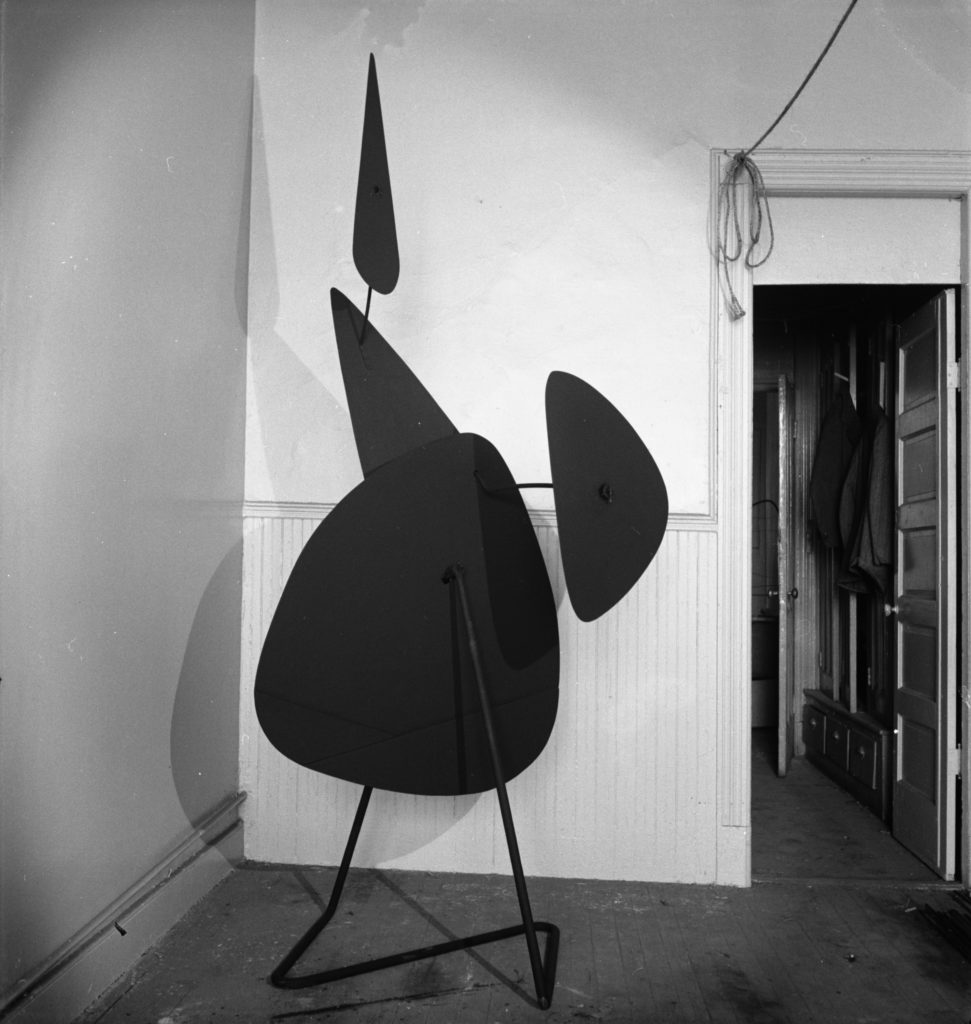
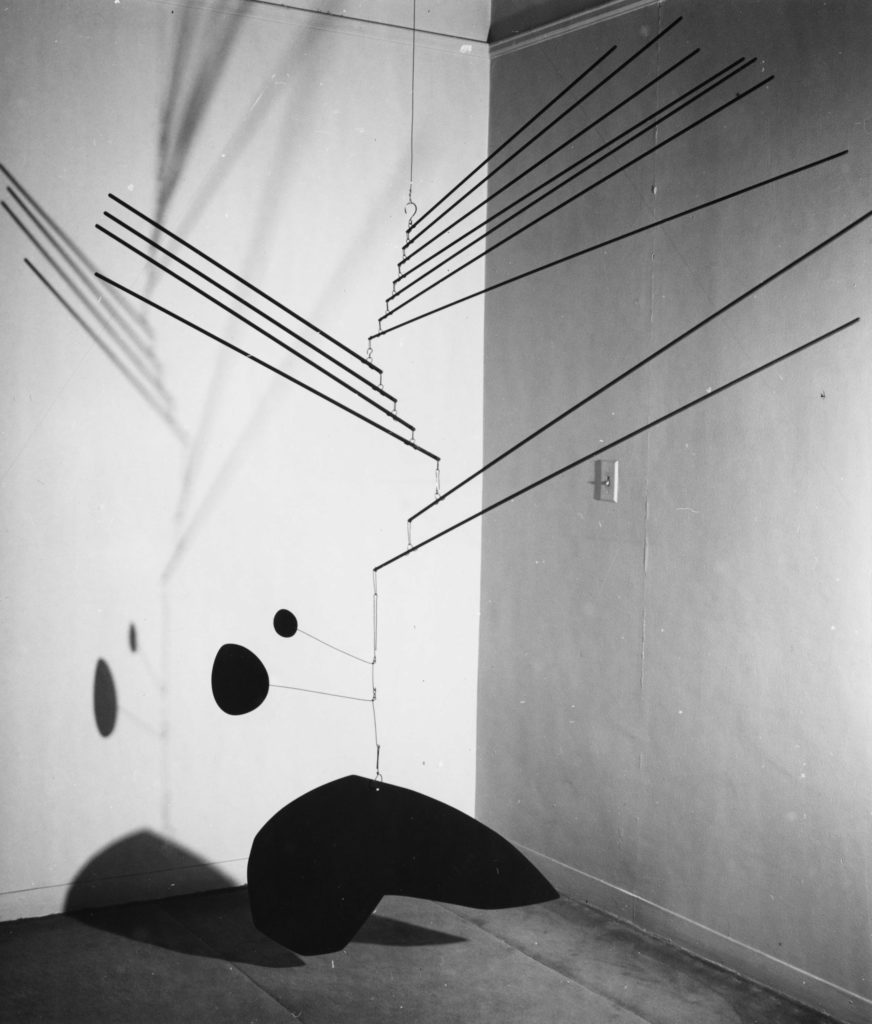

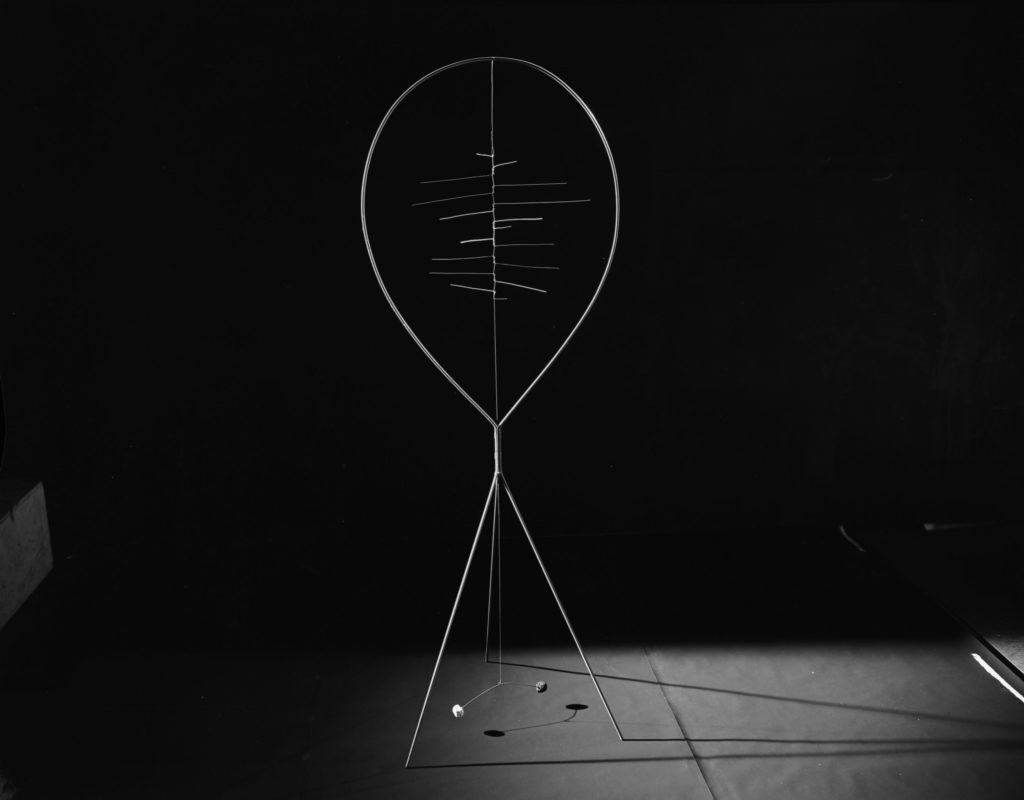

The winter of 1937 Calder spent in England. An exhibition of his work was held at the Mayor Gallery in London. But the spring of 1938, in Roxbury, already saw the fruits of this new-won confidence. His large Apple Monster shows greater freedom in following the suggestions of his material on an increased scale. His motorized panels now took a frank ballet character in several instances, with even a proscenium arrangement in one on which chunky wooden forms were fixed. In the Spherical Triangle he carried the relationship of large black sheet-iron forms from the static character of Whale into the mobile field.
In November, 1938 a retrospective exhibition of his work was held at the George Walter Vincent Smith Art Gallery of Springfield, Massachusetts. Eighty-four items were included, from his earliest wire and wood sculpture, watercolors and drawings to several large mobiles and stabiles of that autumn.
The following spring, for the 1939 New York World’s Fair, he designed a fountain display which he described as a “water ballet.”[9] The dance was to be performed by fourteen forty-foot jets of water thrown up by revolving nozzles. It was punctuated by “water bombs” or isolated bursts of water which fell back into the basin of the fountain with an explosive sound. The entire performance, which should have lasted five minutes, was patterned on a complex choreographic schedule. Unfortunately, he did not receive the same sympathetic cooperation from the New York engineers in charge that he had in Paris. Although the necessary equipment was installed, a failure to follow the stipulated timing destroyed the possibilities of rhythmic variation and defeated the ballet effect.
Throughout this period, however, his mobiles lost none of their rhythmical freedom as is evidenced by the inexhaustible shadow-play of the large Lobster Trap and Fish Tail which revolves in the Museum of Modern Art stair-well. Nor did the scale of his stabiles cease to grow. The dull black, riveted sheet-steel structures initiated with the Whale now lost their curvilinear contours for the predominantly sharp-angle forms of the Black Beast. Even the free-swinging elements moved with a slow, menacing heaviness in pieces like his 1940 Black Petals.
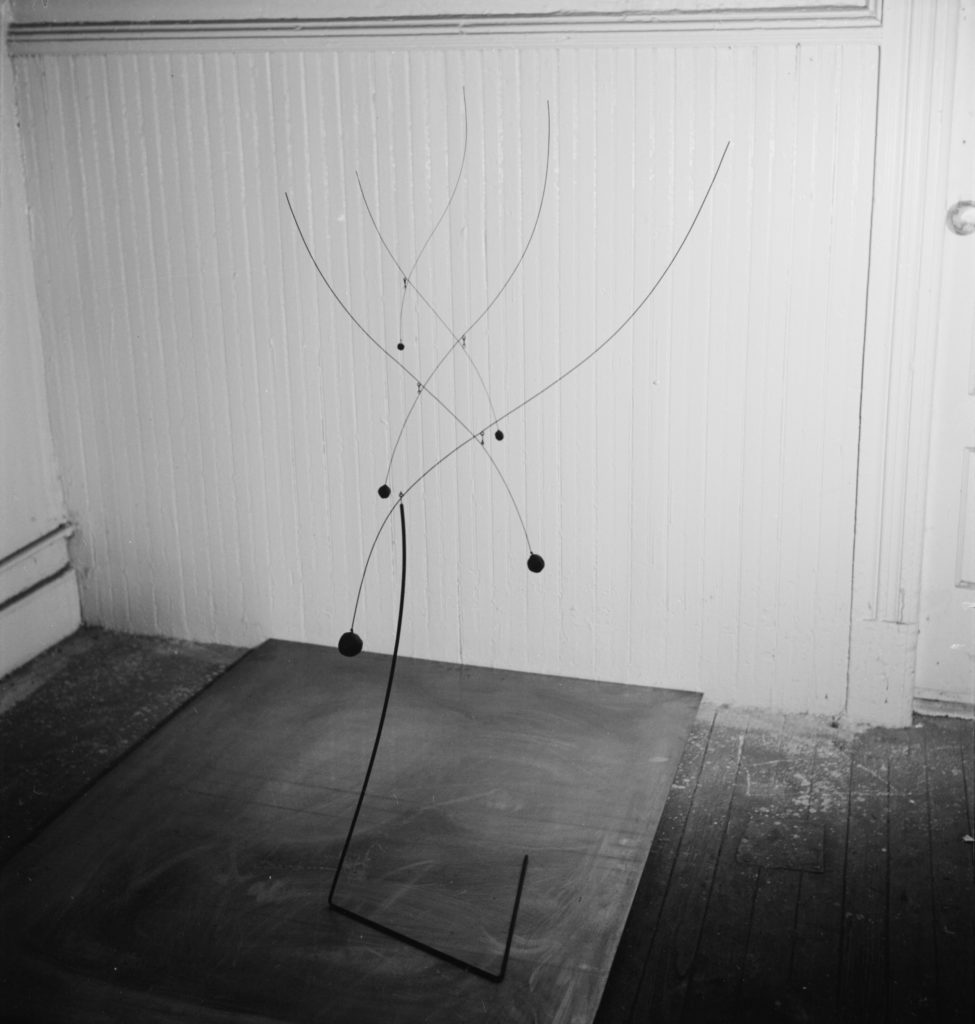
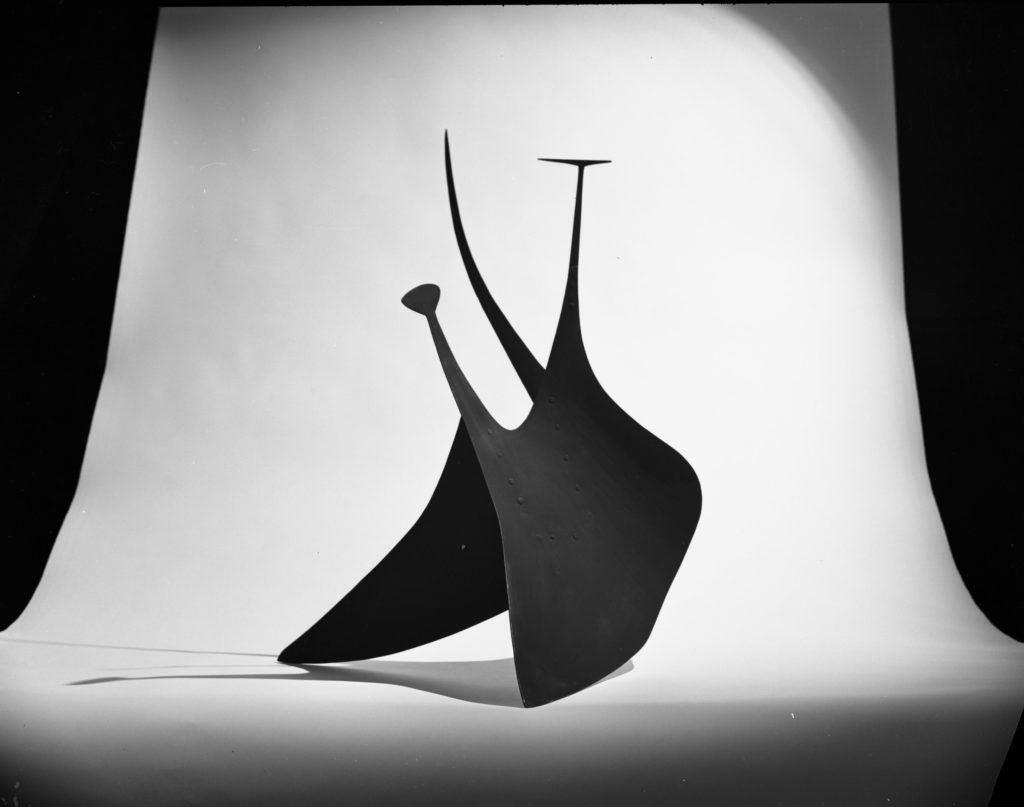
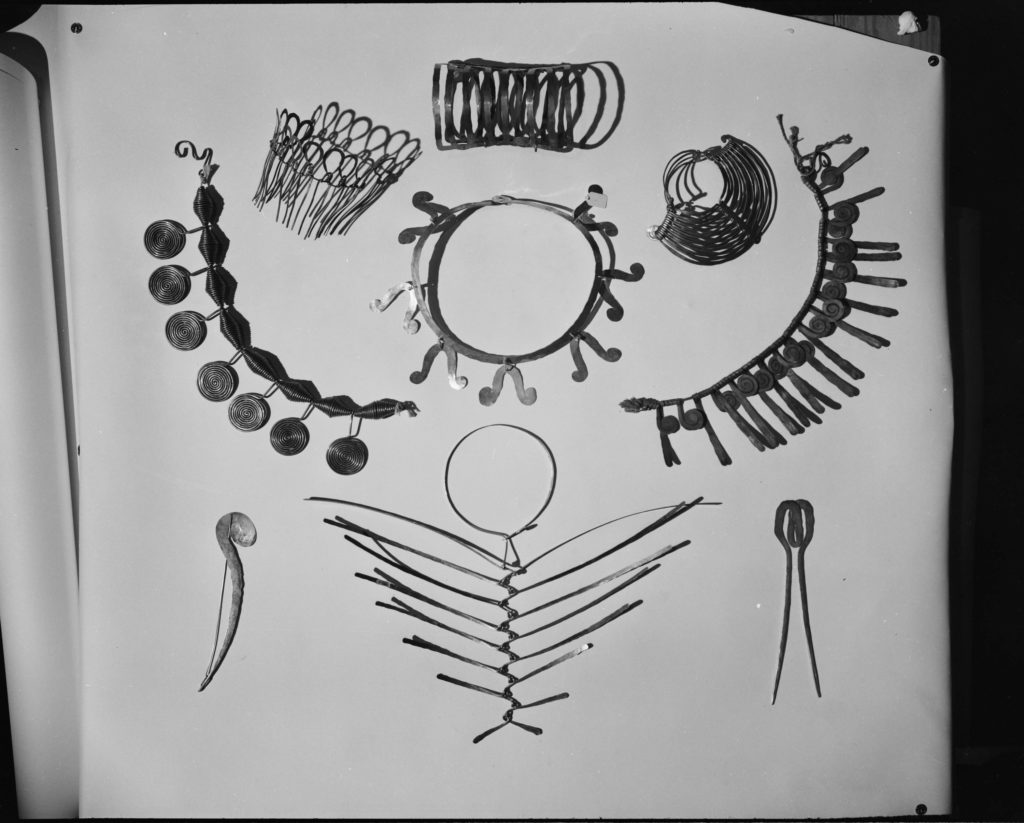


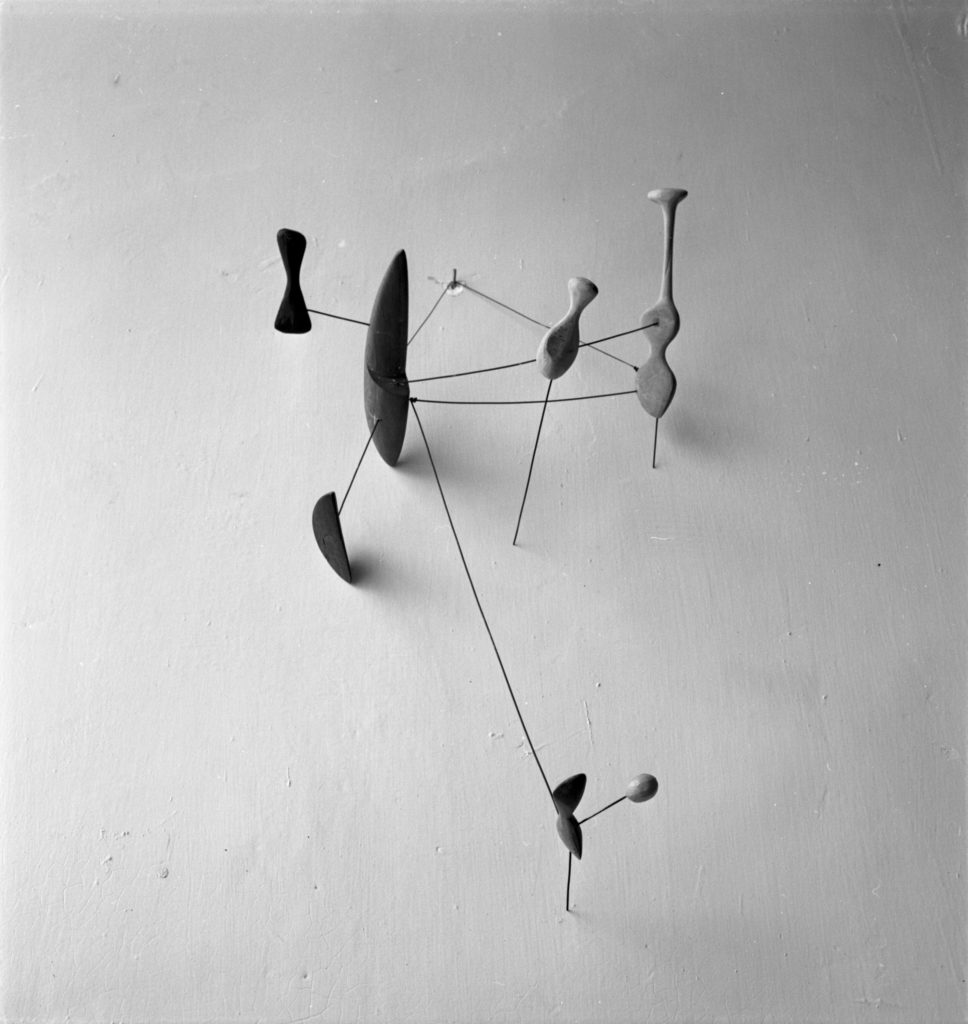
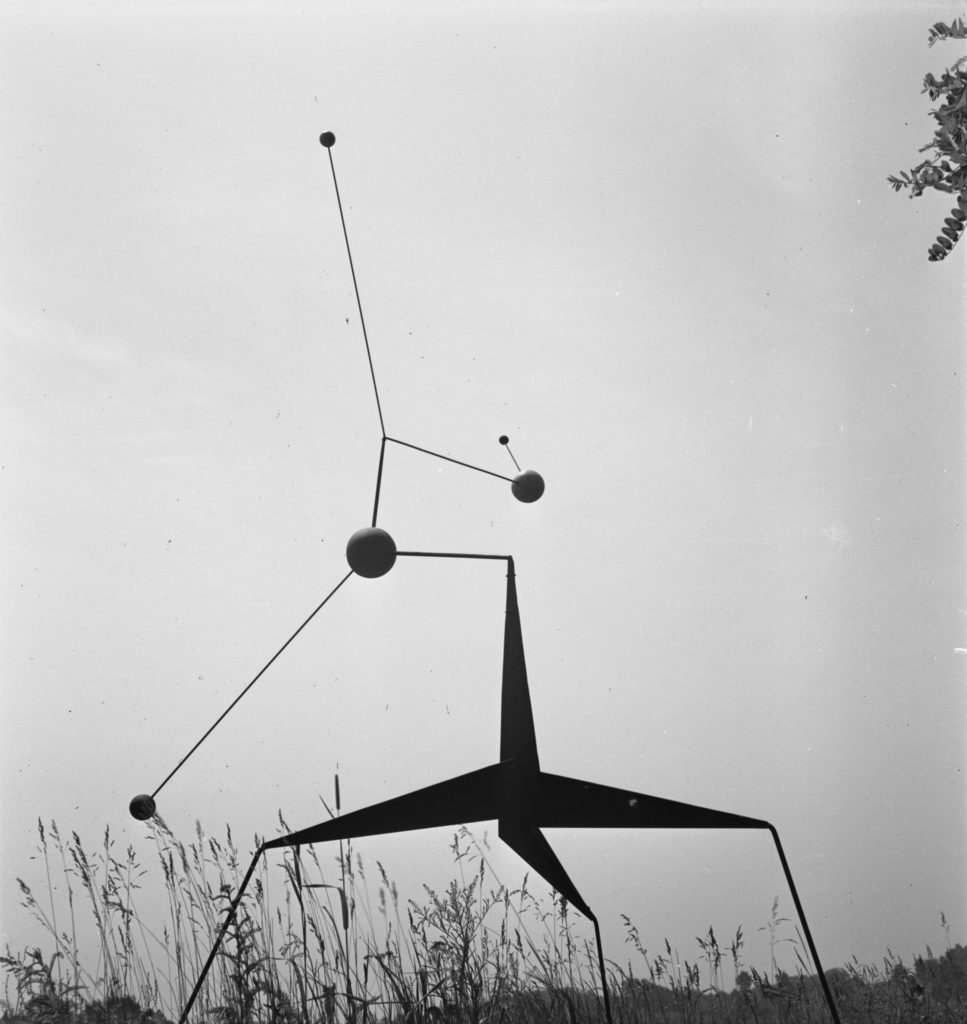
In December, 1940 the first exhibition devoted solely to his jewelry was held at the Willard Gallery, New York. For years he had been making occasional pieces as gifts for his friends. At first they were mainly designed in brass wire. This was either twisted into patterns somewhat reminiscent of Bronze Age ornaments in their simplicity and directness of technique, or into humorous naturalistic forms, or stylized monograms. The technique at the outset was clearly related to that of his first wire sculpture, Josephine Baker. But soon the twisted wire was hammered into flat strips which allowed a greater variety of effects and uses. The humorous and naturalistic treatment became less frequent. Pebbles, bits of colored glass or weathered bones were incorporated, cabochon fashion. Silver and gold wire came to be used more commonly than brass.
The beauty of his jewelry lies primarily in its decorative linear qualities. Nevertheless just as its technique and its linearism had roots in Calder’s early wire sculptures, the grace of its lines and the fantasy of its forms had their echo in a new departure in Calder’s constructions of 1941 and 1942.
Perhaps this change of direction in Calder’s work was in part a reaction from the overpowering, grim, sharp-angled forms of 1940 such as Black Beast. In any case in 1941 we see a turn from these massive, somewhat ominous conceptions to gayer expressions with a recall of color and of slender forms. Where the dull black tone is retained we have a delicacy in formal elements closely reminiscent of his jewelry. Even the fantasy of some of the finest jewelry has its larger realization in mobiles such as the Cockatoo, or the simple, twinkling bars of Hour Glass that spin, fling and balk as the tiny weights which control them from below unwind and rewind.
Then, in 1942, we see in the stabiles a return to the more solid curvilinear forms of 1937 and 1940, but with a new grace inherited from the preceding season. At the same time his mobiles reveal an even fresher fantasy echoing evident features of his jewelry.
A new means to organize three-dimensional space was the search to which Calder as a sculptor was always returning. The scarcity of materials as a consequence of war restrictions in 1943 very possibly forced him to look into a fresh field. Metal became scarcer, harder to find in large sheets. A new type of stabile, which he called a “constellation,” began to appear. This was a structure of small odds and ends of polychromed and unpainted wood fixed together by heavy wire, built to stand on a base in the conventional manner. This type was followed by similar constellations, somewhat lighter in character, made to hang from the wall without obvious means of support. Finally, we have the constellation translated into a stabile, free-standing in space, quite different in character from any of its immediate predecessors.

But the large retrospective of Calder’s work in the Museum of Modern Art in New York in the autumn of 1943 in a sense brought the early phase of his work to a conclusion. He seemed to feel he should try to find a fresh idiom, or perhaps more truly a refreshment of idiom. He spoke of his worry over becoming ingrown, habit-bound and uninventive. He realized that he had developed an ease in the handling of his materials on which he looked with a certain distrust. He was afraid this facility would weaken his expression. To break away from this growing virtuosity he decided to leave his familiar materials, sheet metal, wire and wood, for a brief time at least and once more take up the study of the human form and its treatment in a frank three-dimensionality.
The immediate products of this disciplinary resolve were his carved and modeled works of 1944, such as On One Knee. Some of these were exhibited in plaster, some cast in bronze. Naturalism was the base of Calder’s approach in this new direction, but distortion and a characteristic humorous interpretation kept them definitely out of the conventional field. They served as an exercise and as a redirection of viewpoint as Calder had intended. Further, in plaster some of them had a definite visual appeal. In this first stage Calder could watch the effects he was getting under his hand and work them out with a relative immediacy. But in translation to bronze they almost inevitably lost their quality of material interest and surface liveliness. As soon as a mechanical process intervened between the artist’s hand and the product the vitality of the latter seemed to suffer. Actually there is often the same result when a piece of Calder’s jewelry is cast in a different metal than that in which it was made. It is as if Calder the artisan must be in touch with his expression. In this sense possibly one can never say that he is a true “machine age sculptor.” He remains rather an artist in the machine age—a handicraftsman who merely has at his disposal more sophisticated tools than his predecessors.
To cast the plaster versions of these sculptures into bronze was as costly as it was esthetically unsatisfactory. One exhibition of such work satisfied the artist that he had done his duty in the direction of discipline. 1945 saw him once more working sheet metal, wire and wood as he had for so many previous years, but now with a new grace and a fresh treatment of pierced planes made to swim lazily horizontal.
At the same time, Calder’s stabiles took on a greater complexity of interpenetrating geometrical forms. Now the pierced elements helped to a new lyrical effect. Whereas such a construction as Black Beast of 1940 was ominous, threatening, almost overpowering in its heavy sheets of solid metal, a stabile such as Morning Cobweb, thanks to the subtle contrast of open areas and narrow borders, gives the effect of the lightness and gaiety we have from a mobile. He had finally brought grace and a suggestion of weightlessness into the stabile which formerly had been oppressively heavy. Here the art lay in the suggestion of movement through the interpenetrating planes—what Mondrian had felt Calder should have done when Calder first suggested translating contrasted color areas into actual movement.
In 1945 Calder returned to Paris briefly for his first visit in thirteen years, and made arrangements for an exhibition the following autumn. And in October, 1946, his first European exhibition since his London exhibition of nine years earlier was opened.
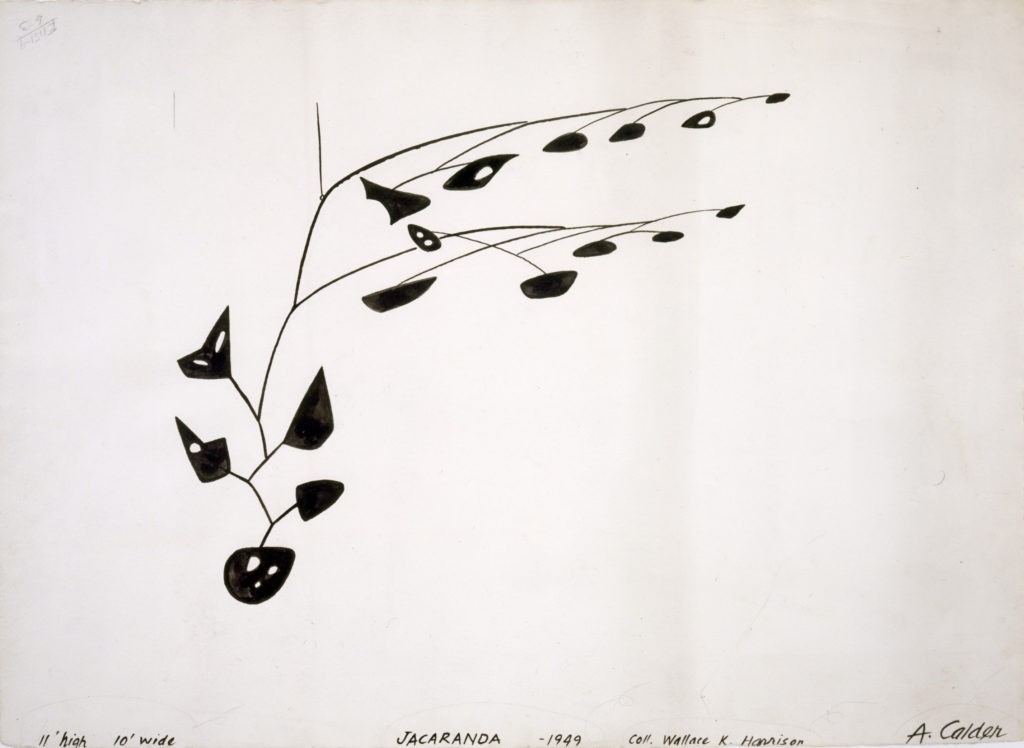
Since Calder’s departure from Paris, and in fact since the outbreak of the war in 1939, a new movement in the arts had been taking place, notably in the literary field, the Existentialism of Jean-Paul Sartre. Sartre had seen Calder’s work while in the United States on a government mission towards the close of the war. He felt that Calder’s art illustrated certain concepts of his philosophy in a way he had not found them embodied in other sculpture. And he contributed an introductory essay on the catalog of Calder’s Paris exhibition at the Galerie Louis Carré.
For Sartre, a mobile was “a little local merry-making, an object defined by its movement and which does not exist outside it, a flower which withers as soon as it is stopped, a pure play of movement, just as there are pure plays of light …”[10]
“Calder,” he continued in his introductory note, “suggests nothing: he catches true, live movements and fashions them. His mobiles signify nothing, they do not send one back to anything but to themselves: they are, that is all; they are absolutes … For each one of them Calder establishes a general career of movement and then he abandons it; it is the time of day, the sunshine, the heat, the wind which will determine each individual dance. Thus, the object remains always midway between the slavishness of the statue and the independence of natural occurrences; each of its evolutions is an inspiration of the moment; one distinguishes in it the theme composed by its author, but it embroiders on that a thousand personal variations; it is a little jazz tune, unique and ephemeral, like the sky, like the morning; if you have missed it, you have lost it forever. Of the sea, Valéry used to say that it is always begun over again. One of Calder’s objects is like the sea and casts a spell like it; always begun over again, always new. It is not a question of casting a passing glance at it; one must live in communication with it and charm oneself on it. Then the imagination is exhilarated by these pure forms which are constantly interchanged, at once free and ordered …
“ … In a word, although Calder has not sought to imitate anything—because he has not wanted to do anything but to create scales and chords of unknown movements—they are at once lyrical inventions, technical combinations almost mathematical and, at the same time, the sensible symbol of Nature—this great vague Nature, which throws pollen about lavishly and will produce brusquely the flight of a thousand butterflies, and of which one never knows if it is the blind chain of causes and effects or the timid development, ceaselessly delayed, thrown out of order, thwarted by an Idea.”
The tropical jungle of Calder’s tinkling lianas, fluttering birds and crouching metal forms was something fresh in Paris. Calder brought an art expression that was not immediately associable with the work of the great leaders of the prewar years, or even of the years before World War I, as was so commonly true of the most ambitious work visible in Paris exhibitions at the time. Calder brought something fresh—something characteristically youthful, something blithe, something gay. He was an American. He was an American speaking an international language, not a regional expression. Furthermore, he was an American not emulous of the accents of the boulevard. He was an American who spoke in his art with his own personal accent. Mark Twain once said “There is not one single known characteristic which can be safely labelled as American.” There was something different about Calder. What was different was his own. He was born in the United States; the Parisians, therefore, felt this difference must be his American note. The logic was not sound, but his exhibition at the Galerie Louis Carré was a success.
The following year Calder exhibited his work with Fernand Léger’s in Berne and Amsterdam. The Kunsthalle of Basel and the Stedelijk Museum, Amsterdam, purchased mobiles. In 1948 work was begun on a film of Calder’s work by Herbert Matter and Burgess Meredith with music specially composed by John Cage. Matter based his approach to Calder’s work on a comparison of its rhythms with rhythms of nature: waves lapping a beach, the flight of clouds, the movement of branches and fluttering of leaves. In the final realization of the film, Matter’s sympathy with Calder’s work and his own photographic artistry produced perhaps the most satisfactory interpretation of a contemporary artist’s work in cinema yet produced in the United States.
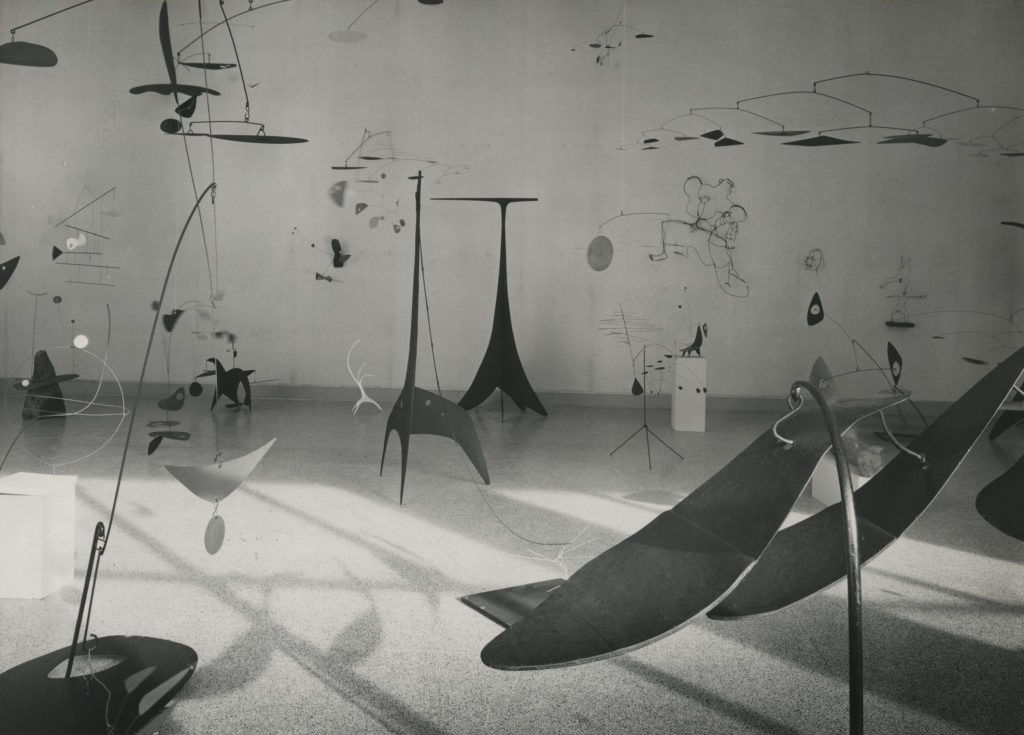
In the latter half of 1948 Calder brought an exhibition of his work to Rio de Janeiro and São Paulo in Brazil. He went by way of California and Mexico. Two years later, in the summer of 1950, he had returned to Paris and was enjoying another exhibition success at the Galerie Maeght. That December, Massachusetts Institute of Technology in Cambridge undertook the most comprehensive showing of Calder’s work since the Museum of Modern Art exhibition in New York seven years earlier.
All this time his work was showing a steady refinement and increased complexity. Still the fundamentals of his approach had not changed. In 1943 he had stated in an interview: “I feel an artist should go about his work simply with great respect for his materials … Sculptors of all places and climates have used what came ready to hand. They did not search for exotic and precious materials. It was their knowledge and invention which gave value to the result of their labors … Then there is the possible handicap of being over equipped, of having more tools and material than one knows what to do with … Simplicity of equipment and an adventurous spirit in attacking the unfamiliar or unknown … In my own work, when I began using wire as a medium, I was working in a medium I had known since a child. For I used to gather up the ends of copper wire discarded when a cable had been spliced and with these and some beads would make jewelry for my sister’s dolls … Disparity in form, color, size, weight, motion is what makes a composition, and if this is allowed, then the number of elements can be very few … Symmetry and order do not make a composition. It is the apparent accident to regularity which the artist actually controls by which he makes or mars a work.”
This is the point of view, in Calder’s own words, which guided him during his early years in Paris and underlay his later work in the United States; and this is still the basis of his work’s individuality, freshness and youth today.
The Museum of Modern Art, New York. Alexander Calder: Sculptures and Constructions. 29 September 1943–16 January 1944.
Solo ExhibitionCalder, Alexander. “What Abstract Art Means to Me: Statements by Six American Artists.” The Museum of Modern Art Bulletin, vol. 18, no. 3 (Spring 1951).
MagazineCalder, Alexander. “Voici une petite histoire de mon cirque.” In Permanence du Cirque. Exhibition Catalogue. Paris: Revue Neuf, 1952.
General ReferenceWorld House Galleries, New York. 4 Masters Exhibition: Rodin, Brancusi, Gauguin, Calder. Exhibition catalogue. 1957.
Alexander Calder, Statement
Group Exhibition CatalogueRodman, Selden, ed. “Alexander Calder.” In Conversations with Artists. New York: Devin-Adair, 1957.
General ReferenceCalder had a major show in 1946 at Galerie Louis Carré in Paris for which Jean-Paul Sartre wrote a seminal essay. He designed sets and costumes for a number of theatrical performances and designed a huge acoustic ceiling for the Aula Magna auditorium at Universidad Central de Venezuela. In 1952, Calder represented the United States at the Venice Biennale, winning the grand prize for sculpture.